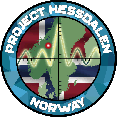Project Hessdalen 1984 - Final Technical Report
By MSc.EE. Erling Strand
Foreword
1. Introduction
2. The Instruments
3. The Results
- 3.1 The lights
- 3.2 The spectral-analysis
3.3 The Seismograph
3.4 The radar recordings
3.5 The Spectrum Analyser
3.6 Magnetometer
3.7 Laser
3.8 Geigercounter
3.9 IR-Viewer
3.10 F10 Lights
- 4. DISCUSSION
- 4.1 The sightings
4.2 The spectral analysis
4.3 The radar and spectrum analyser
4.4 The magnetometer
4.5 The laser
4.6 The geigercounter and the IR-viewer
4.7 The "nonworking" instruments
- 5. CONCLUSION
- APPENDIX
- A1. Summary of the reports
A2. Overview on some of the films
A3. Registrations on seismograph
A4. Registrations on radar
A5. Registration on spectrum analyser
A6. Registrations on magnetograph
- The temperature and the sightings
- An aeromagnetical map
- The geology
- The pictures
FOREWORD
The report first give an introduction to the project. Telling
about the history of the lights and the running of the
project. Then it lists all the instruments, and the arguments
for using these instruments. Then it presents the results. All
the details about the measured data are in the appendix. The
fourth chapter discusses what we learned during the project
part 1, and what we should have done differently. At last,
there is a conclusion.
1. INTRODUCTION.
Hessdalen is a valley in the middle part of Norway, south-east
of Trondheim, about 30 km northwest of the town Røros. The
valley is about 12 km long, and about 150 people live there.
In December 1981, unknown lights suddenly started to show up.
The lights could stand still for more than an hour, they could
move around slowly, and sometimes they could stop. They could
also show a large speed: at one time a speed of about 8500
m/s was tracked by radar.
These lights could be anywhere. Sometimes they were reported
to be just above the roof of the houses, or just above the
ground. Sometimes they could be high up in the air. Mostly the
lights were reported to be below the tops of the mountains
nearby. No one could give explanations for these lights.
The lights appeared to have different specific forms. This
showed up on the photos. It could have a form of a bullet,
with the sharp end down. It could be round as a football. It
could be as a "Christmas-tree" upside down. The colours were
mostly white, or yellow-white. Sometimes it could have a small
red light, usually on the top or bottom of the white. A few
times it seemed to have all the colours; red, green, blue,
yellow, at the same time. And sometimes, on the photos, we can
see a blue light.
The lights were occuring several times a day, but mostly
during the evening or nighttime. At the most, it could be seen
about four times a day. All of these were actually in the
valley. If we had counted those lights that showed up higher
in the sky also, it could have been a higher number. There
were more lights in wintertime. In summertime, lights were
seldom seen at all. One reason for that might be that there is
daylight almost whole night in summertime in Hessdalen.
The lights could be split in three groups:
-
-
- 1. Small and strong white or blue flashes, which could
show up everywhere in the sky.
- 2. Yellow or yellow-white lights. These lights have
very often been seen in the valley, just over the
roof of the houses, or even down on the ground. They
could be stationary for more than an hour, move
slowly around in the valley, and sometimes show
large accelerations and speeds. They could also be
higher up in the sky. Mostly they moved on a
north/south course.
- 3. Several lights together with a fixed distance from
each other. Mostly it was two yellow or white lights
with a red in front. Many people talked about "The
object", when they saw this type of light. These
lights could move slowly around the top of the
mountains. The direction of "travelling" was mostly
on a north/south course.
-
Suddenly, in the spring of 1983, the lights seemed to be much
more seldom. In the summer of 1983 we got no reports. However,
in the autumn and winter reports started coming in again, but
much fewer than the years before. However, in this autumn
(1984), we have got more reports than last autumn.
As no official institutes with governmental support seemed to
care about these unknown lights, five persons started their
own project. The aim of the project was to find out what this
phenomenon in Hessdalen and nearby areas was. Even if we
didn't succeed in that, we hoped to find out a little bit more
about the phenomenon than what we knew before. This is the
report on part 1 of this project. If founding is available, we
will go on for another year.
The project consists of a "working committee", which has the
responsibility for running the project, and an "advisory
committee", which should help the working committee in the
theoretical part. It should act as an expert group and answer
questions from us; the working committee. (The fact is that
the advisory committee got very little work from us, because
we managed to build up a local expert group, consisting of
people from Norwegian Defence Research Establishment (NDRE),
the University of Oslo and the University of Bergen. In these
days, the University of Trondheim also joins the group.)
The project was born on 3 June 1983. On 27 August it was
presented on BUFORA's 3. international UFO-congress in
England. During the autumn a research program was established.
On 19 November the project was presented to the people in the
valley. During the first part of January 1984, an information
bulletin, explaining about the project, together with a simple
report form, which people should return to us, were sent out
to 3300 households in the district. The work in the field,
with all the instruments, started on 21 January 1984, and
ended on 26 February.
The work in the field started with a "test weekend". This
weekend should be a training session for the main part, which
should go on from 11 February to 26 February. During the test
weekend about 22 persons were present. Some of these people
could be on duty between the test weekend and the main part.
Therefore, we decided that the project should go on, all the
time from 21 January to 26 February. During the time between
the test weekend and the main part there were few observers
present. From Monday 23 January to Friday 27 there were 5
people. After that, only one or two people were on duty. That
is perhaps the main reason why there are few reports during
that period. In the main part, from 10 february to 27
February, the number of observers was as shown in fig. 1.1.
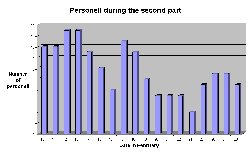
Fig. 1.1. - The number of observers during the main period.
The people in the field were divided in three groups during
the test weekend. Some on the headquarter on Aspåskjølen, some
on Finnsåhøgda, and some on Fjellbekkhøgda. For a short
period, some people were at Heggset, too.
During the main period, from 11 February to 26 February,
people were divided in three groups, but now the field-
stations were at Hersjøen and Litlfjellet. The headquarter was
still at Aspåskjølen. The headquarter was a caravan, with most
of the instruments in it.
Some of the photos that were taken of the Hessdals-phenomenon
prior to the project period, are in the appendix.
- Acknowledgements. -
I wish to express our thanks to:
Norwegian Defence Research Establishment (NDRE), especially
Dr. E. Thrane and T. Blix for all help in planning the field
investigation, getting instruments, and discussion of the
results.
O. Andreassen at the "Institute for theoretical astrophysics",
for all discussion, planning and analysing the spectral
photos.
J. Havskov at the Institute of Solid Earth Physics, for all help in
planning, installation and analysing the results from the
seismograph.
H. Bungum at NORSAR, for supporting us with seismological data
and useful discussions.
Professor Egeland and several of his men at the Physical
Institute at the University of Oslo, for useful discussions.
Professor J.A. Hynek, Prof. J.A. Tellefsen, Dr. H. Rutledge
and P. Devereux for being in the "Advisory Committee".
The people in the valley for providing us with living
quarters, transportation, power to the instruments, and
supporting us with positive attitude.
All those who performed excellent fieldwork, free of charge:
L.G. Börling, L. Berggren, L.S. Berlin, J.W. Bjordammen, D.
Ekenhage, U. Ekstedt, C. Flemk, H. Gullberg, P.E. Gullberg, M.
Heim, J. Hjelvik, J. Karlsson, S.E. Knutsen, M. Kaarbø, B.
Lagesson, A. Lindholm, I. Lindstrøm, O. Lövgren, K. Malvik, D.
Mattson, K.A. Mattsson, K. Melander, M. Nielsen, M. Nilsson,
C. Nordin, S. Ohlsson, M.B. Pellving, K. Persson, K.O.
Petterson, H. Svaerd, U. Tellander, A.P. Thomassen, T.
Thomassen, B. Tyselius, J.K. Quam, K. Aakerlund and others
that helped in the project.
The three organisations: "UFO-Norway", "UFO-Sweden" and
"Föreningen för psykobiofysik", which supported this project.
Per Solerud for developing most of the films. Knut Aasheim,
Hans Kristian Moe and Rønnaug Hansen for discussion and
correction of this report.
The working committee has consisted of:
L. Havik, O.G. Røed, H. Ekstrand, J. Fjellander and myself,
Erling Strand. Together we acted as a project leader-team,
which had the responsibility for each part of the project.
[Map of Hessdalen will come]
2. THE INSTRUMENTS
We were facing something unknown, mostly reported as light
sources. We wanted to find out what this could be. What should
we do?
We focused upon the lights, mainly because most of the reports
were dealing with them, and because they were most likely to
give results. To find out what kind of instruments we needed,
we first studied some of the reports, then we studied what
people had proposed as solutions for these unknown lights.
That led us to the following instruments:
- Camera with gratings
This is the best way of getting information of what kind of
light source we are dealing with. Is it a continous spectrum,
or is it not? That is: Is it a light due to a thermal process,
or is it not. If not, what gas-combination can it be? If it
is, the big question is: What is the energy source?
This is probably one of the most important measurements to be
done. If we get an answer to this, then we can choose the
further procedure. It will also elliminate the wrong
hypothesis. Plasma phenomena may give a line spectra, as for
instance the aurora.
We obtained totally 6 gratings, 3 especially designed for
spectral analysis: Paton Hawksley TE.216E. We also got one
Paton Hawksley TE.218C and TE.215.
- Seismograph
Is this light due to movements in the ground? This is a
hypothesis widely discussed these days. The hypothesis was
proposed by P. Devereux in his book: "Earth Lights". There
could either be a direct connection with movements in the
ground, or it could be a connection with the tension in the
ground just before or after a movement in the ground.
That hypothesis was the background for the seismological and
geological investigation. We installed a seismograph; "MEQ-800
Portable Seismic System", in Hessdalen in October 1983.
We have also got detailed stereoscopic pictures from Hessdalen
and the nearby areas. We could then find out more about the
geology. This work is done by Dr.Sc.nat. M. Heim.
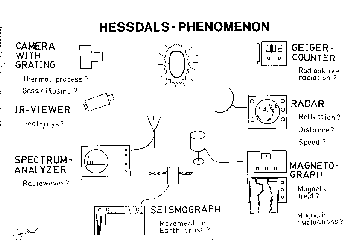
["HESSDALS-PHENOMENON" - a drawing of some of the instruments]
- Radar
Do these lights reflect radar waves, and if they do, what is
the distance and speed of these lights?
This leads us to the radar: "Atlas 2000". This radar has a
wavelength of 3 cm, with a maximum distance of 33 km.
- Spectrum analyser
Many reports from other parts of the world indicate that there
has been electrical interference when an unknown aerial
phenomenon is nearby. Radio communication has been affected.
Even though, nothing of this has been reported from Hessdalen,
we decided to monitor the spectrum. We coupled a broadband
antenna to a spectrum analyser, which swept from from 150 KHz
to 1250 MHz continously. This was a Hewlett-Packard, with a
8554L-RF Section, 8552A-IF Section and 141S Display Section.
We also got a radio interference and field intensity meter;
Singer NM-25T. This instrument cover the band from 150 KHz to
32 MHz. The purpose of this instrument was to measure the
strength of any unknown source detected by the spectrum
analyser.
- Magnetometer
There is an hypothesis claiming that this phenomenon may be
associated with a magnetic field.
We wanted to test this hypothesis as well. We also wanted to
see if there were any connection with magnetical fluctuations
(which occur frequently). We got a Fluxgate Magnetometer;
Model FM100, Serial 73. This device had a high sensitivity:
1000 gamma gave a reading of 1 Volt. It had three outputs: X
(towards north); Y (towards east) and Z (vertical). We
connected this to a two-channel recorder: TOA Electronic
Polyrecorder Model EPR-200A. Then we could record two (of the
three) dimensions. This recorder was available only for a
small period of the project. Whenever it was not available, we
used an Esterline-Angus Graphic Ampmeter.
The magnetometer was mainly designed to measure slowly varying
magnetic fluctuations, as for instance magnetic storms. It was
not a pulsationmeter. It had a frequency response within 3 dB
from DC to 0.5 Hz. Some of the pulsations were recorded when
we used the TOA Polyrecorder. Sometimes they could be hard to
read.
- Laser
A couple of reports from Hessdalen state that the light
disappeared when a strong light-source was directed towards
it. We wanted to test if this was correct. Therefore, we got a
633 nm laser from Spectra-Physics Inc. Model 155. This had a
power of 0.4 to 0.76 mW in the TEM (00) mode. The divergence
was 1 mrad.
- Geigercounter
Some people have claimed that there have been radioactive
radiation from such uknown phenomena. Therefore, we got three
geigercounters, which continously measured the background
radiation. We had two Radiation Alert Mini, and one home-made
with digital read-out.
- IR-Viewer
If there is any strong IR-radiation from these lights, it
might be seen with an IR-viewer. We got two of these, from
FJW, model 80045.
3. THE RESULTS
3.1 The lights.
During the project period in the field, from 21 January to 26
February, we obtained 188 reports on different lights. These
reports have been characterized by two indices:
- One describes the quality of the report, and is given values
from G1 to G10. If the report has very few details, it will
probably get a G1. If the report is well documented with many
details, it will get a G9 or G10.
- One index indicates the probability of finding a natural, or
a "known-light" - explanation. If one can decide, with
absolute certainty, that the light the report refers to, is a
known light, i.e. an airplane, the report will get an F1. If
no explanation is found, it will get an F10.
How can we decide if the report shall get for instance an F5
or an F6? This is of course very difficult, and we have not
any specific rules that make the decision clear to us. It is
therefore a subjective decision, but it is made by two
persons. Even if one report has got a G5 and should have got a
G6, the result of giving quality marks is good enough to get
an overview of the reports. The same arguments applies to the
F-category.
If you study table 3.1, you notice there are few reports which
both have a high F-score and high G-score. There are 6 reports
with F9 and higher. 4 of them have got G7 or higher. That is
too little to draw any conclusion about the nature of the
light, or to find anything in common. You will find the
details about the lights with high F-numbers in chapter 3.10,
and in the appendix.
After studying the reports, I will set a threshold between F4
and F5. A report which has got an F5 or higher might be the
Hessdals-phenomenon. If we study all reports which have got an
F5 or higher, we see that about 68% moved along a north-south
axis. If it was exactly on the axis is hard to say. 12% had
other moving directions. Three lights (two of them have got an
F10) changed moving-direction during the observation. Two
moved up and down (one F9), and 6 reports have not indicated
anything on how the lights moved.
Among these 53 reports, three indicate a special kind of
movement. One of these was photographed (picture RW1/3). In
the picture, you see the start of an oscillation. The
frequency of this oscillation is 7 Hz +/- 2 Hz. The report
tells that this oscillation was growing in amplitude until the
light disappeared. Another report indicates that a flickering
light stopped flickering, made a big jump, and started
flickering again. All the time was it moving towards north. A
third report tells about a "waving movement" when it was
moving towards north.
39% of the reports (F5 and higher) indicate some kind of
flickering. Two F10 lights were among these. 57% do not
mention flickering at all or they say it is a stable light.
Table 3.1 - Categories of the reports. G=good (G10=best; many details in the report) F=strange (F10=very strange phenomenon)
| | G1 | G2 | G3 | G4 | G5 | G6 | G7 | G8 | G9 | Sum |
| F1 | 0 | 8 | 6 | 4 | 1 | 13 | 2 | 47 | 5 | 86 | Total 135
reports about
"A known light" |
|---|
| F2 | 2 | 8 | 0 | 2 | 3 | 1 | 1 | 1 | 0 | 18 |
|---|
| F3 | 0 | 3 | 1 | 1 | 2 | 1 | 0 | 0 | 0 | 8 |
|---|
| F4 | 0 | 1 | 7 | 1 | 4 | 3 | 7 | 0 | 0 | 23 |
|---|
| F5 | 0 | 0 | 3 | 2 | 2 | 0 | 4 | 5 | 0 | 16 | Total 53
reports about
"The Hessdalen Phenomenon" |
|---|
| F6 | 0 | 4 | 1 | 1 | 1 | 3 | 4 | 3 | 0 | 17 |
|---|
| F7 | 1 | 1 | 0 | 1 | 0 | 2 | 1 | 0 | 0 | 9 |
|---|
| F8 | 0 | 0 | 0 | 0 | 0 | 2 | 3 | 0 | 0 | 5 |
|---|
| F9 | 0 | 2 | 0 | 0 | 0 | 0 | 0 | 0 | 0 | 2 |
|---|
| F10 | 0 | 0 | 0 | 0 | 0 | 0 | 2 | 0 | 2 | 4 |
|---|
| Sum | 3 | 27 | 18 | 12 | 13 | 25 | 24 | 59 | 7 | 188 |
|---|
3.2 The spectral-analysis.
Out of seven films that were taken with a grating in the
front, only four pictures are good enough to see some kind of
spectrum. Two strong ones and two weak ones. None of these
pictures were taken of a light that have got an F10-G9.
The two strong ones are taken of a light which have got an F5.
With other words; it might be a known light. They are taken by
Björn Lagesson, Sunday 26 February at 03.08 am. The light was
in the mountainside, northwest (azimuth 366 degrees out of
400) of the field-station at the lake Hersjøen. First there was a
strong flash, then after 20 seconds, a strong "spotlight" was
pointing at the observers for a couple of seconds. Then the
spotlight was directed straight down for a couple of seconds.
Thereafter the direction of the spotlight moved upwards and
round in a half-circle, and back to the observers once more.
Then it suddenly "turned off". The time from the first flash
to the "turning off", was about 3 minutes. There were three
observers observing this light. One of them thought it might
be the spotlight from a snowscooter. But he was not sure,
because the light seemed to be "too strong for that", and it
had a little bit "strange movement". Anyway - this made it
only an F5-light, even if it is strange that anyone should be
out in the mountains at that time of the day. You find the
pictures in appendix. Fig. A8.
One of the weak ones, with G7-G6, is analysed in a computer at
the University of Oslo. The conclusion of this work is that it
is too weak to say what kind of spectrum it is. It seemed to
be some kind of spectrum from 560 nm to 630 nm. The maximum
wavelength the film (Kodak Tri-X) can tolerate, is about 630
nm. We chose to analyse this picture, because it was best
documented, and had the highest F-score. The picture was taken
by Arne P. Thomassen on 25 January at 7.10 pm. He and his
wife, Tone, was at the southern part of the mountain Finnsåhøgda. They saw
a bright "planet" low in southwest. It was as bright as Venus
at the strongest. It didn't move for a couple of minutes. Then
it started to move towards north, on their western side. Arne
shot three pictures. Just after Arne had shot the pictures,
the light suddenly speeded up and disappeared. You will find a
copy of the picture Arne took in the appendix, together with
the data analysis.
We have also one picture taken by me, on 21 January at 7.30
pm. This is also too weak to say what kind of spectrum it is.
The picture have also a lot of low and high orders of star
spectra.
As I have mentioned earlier, I will set the criterion between
F4 and F5: any light that has got a "score" of F5 or higher,
should be treated as if it was the Hessdals-phenomenon.
Because the pictures you see in the appendix, taken on 26
February, lie just at the limit, these pictures cannot be used
as a proof that the Hessdals-phenomenon has a continuous
spectrum.
3.3 The seismograph.
The seismograph was installed on 24 October 1983. We have not
recorded any local seismic activity. All recordings on the
seismograph was from earthquakes, or movements in the ground,
with epicenters long away from Hessdalen.
The sensitivity we obtained with this installation was 1.5 on
the Richter scale.
The Hessdalen area is not well covered from other
seismological stations. In Norway, the nearest station to the
south is Hamar, to the west Florø, to the north Tromsø. There
has to be a quake with greater amplitude than 2.5 on the
Richter scale in the Hessdalen area, to be detected on one of
the nearest stations.
Inside a radius of 70 km from Hessdalen, there have been
detected four quakes, all small in amplitude, during the last
6 years. Inside a radius of 50 km, there have been 15
recordings, during the last 100 years. Even though the area
hasn'y got any good cover, one can say that there is very
little seismological activity, compared to other areas in
Norway.
Until now, we have not found any connection between the
phenomenon and movements in the ground.
Details of the recordings on the seismograph (from quakes in
other parts of the world), and a list of seismological
activity from 1887, within 50 km from Hessdalen, will be found
in the appendix.
3.4 The radar recordings
Totally, we have 36 radar recordings. Three of those were
probably also seen as lights. All the others were not observed
visually. Nine times we could follow this reflection on the
radar screen, travelling on a nearly straight line. We have
taken pictures out in the air, where the radar screen said
there was something. But the pictures didn't show anything
unusual.
Most recordings were done on 2, 3 and 4 February. More details
in the appendix.
Two times we managed to take a picture of such a reflection.
As you can see in the picture (figs. A9 and A10 in the
appendix), this reflection is as strong as the reflections
from the mountains. Such a strong reflection can be caused by
a solid object, a strong gradient of for instance temperature,
humidity or pressure. The picture is analysed by a radar
expert at NDRE, and he said: "If this isn't a reflection of a
solid object, but only gas in the air, the gas has to be
locally and strongly ionised. Otherwise, it wouldn't give such
a strong reflection".
We did not get reflections from all lights. The reason for
that might be the following: Mostly, we had the radar adjusted
to show only 5.5 km. Those three times we did get anything on
radar together with light, happened when the screen was
adjusted on a longer distance. The reason might be that the
lights were out of distance when the radar was adjusted to 5.5
km.
Why didn't we have the radar adjusted to maximum range; 33 km,
all the time? The reason for that is that we waited for the
light that used to travel in front of Finnsåhøgda. Then we had
to have it adjusted for a shorter distance. It is about 2 km
to the mountain Finnsåhøgda.
One of the three times the light was followed with the eyes
and was seen as a reflection on the radar screen at the same
time and direction, there were reflections every second sweep.
But the light was seen all the time. Could it be that the
light does not reflect radar waves all the time? Only
sometimes? The same thing happened a couple of times when we
didn't see the light: Reflection every second sweep. Is it
possible that it might "react" to radar waves? Was it because
of the radar that it didn't reflect the second time? The
technical data on the radar, and a copy of some of the
recordings will be found in the appendix.
- The first time we saw a reflection on radar in the same
direction as we saw the light, was on Saturday 21 January at
5.50 pm. It was a light which travelled towards north-
northeast over Finnsåhøgda. When it was in the north, it
nearly stopped travelling and suddenly went right down and
disappeared. We got one reflection on the radar in the same
direction (+/- 5 degrees), when it went straight down.
- The second time was on Wednesday 25 January at 5.32 pm. The
observers said: "A big object came from the south, moving
towards north over the mountain Finnsåhøgda". When the light was just over
Finnsåhøgda, there was a reflection on the radar, in the same
direction (+/- 5 degrees) as the observers saw the light. The
light was travelling slowly towards the north, all the time.
On the next radarsweep, no reflection was seen. On the sweep
after that, it was seen again. No more reflections were seen
as it travelled further towards north.
- The third time was on Friday 27 January at 10.58 pm. A light
was travelling from south to north. The speed seemed to be
very large. There were two echoes on the screen. The time
between them was 2.4 seconds, and the distance between them
was about 20 km to 21 km. Just after (3 seconds) it was seen
on the radar, the radar observer went outside. The observers
outside told what they had seen. Both the direction of motion
and the speed they indicated, seemed to be the same as the
radar observer saw. The distance is hard to decide for the
observers. The accuracy of the time of observing visually and
on the radar is within about 3 seconds.
3.5 The Spectrum Analyser
We did not see anything on the spectrum analyser at the same
time we saw the lights, but we did get some unknown recordings
at other times.
The analyser was adjusted to show the whole frequency band in
one sweep. That is from 100 kHz to 1250 MHz. These unknown
recordings showed up as "spikes" with about 80 MHz between
them. They went up and down with nearly equal amplitude on the
whole band.
These recordings were done from 29 January to 3 February, with
a maximum on 3 february.
A natural explanation of these recordings, is noise from the
radar. An argument against that explanation is the fact that
we saw no noise on the radar screen when we got the spikes on
the spectrum analyser.
3.6 Magnetometer
We have not found any simple correlation with the phenomenon
and the "slowly-varying" magnetical fluctuations. But there is
a correlation of about 40% with the pulsation-registrations: 4
of 10 registrations with an F5 or higher, from 11 to 14
February, came almost exactly at the same time as a pulsation.
But during those days, there were many recordings of
pulsations. So there is a possibility that there was a
coincidence that the light showed up the same time when there
was a pulsation. More observations are needed.
The reason why we had recordings of pulsations only from 11 to
14 February, is because that was the time we had a recorder
that was fast enough to record the pulsations; TOA Electronic
Polyrecorder. The other times, we had the Esterline-Angus
Graphic Ampmeter, which only recorded the slowly-varying
magnetical fluctuations.
If we go on for another period, we should have a pulsation
magnetometer. Even though the Fluxgate magnetometer did record
pulsations, it could sometimes be difficult to read the
pulsations. Especially when there were magnetical storms.
In the appendix, you will find the collected data from the
magnetometer. In the tables below, you find the times and
approximate amplitude of the of pulsations, and the F-number
of the lights.
OVERVIEW OF THE PULSATION RECORDINGS AND
THE LIGHT RECORDINGS
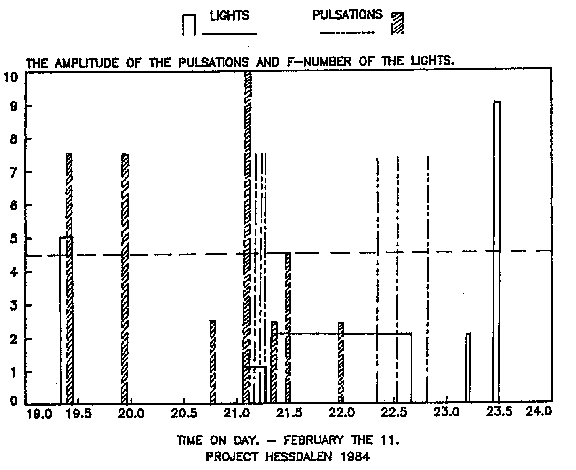
Fig. 3.6.1 - Recordings on 11 February.

Fig. 3.6.2 - Recordings on 12 February
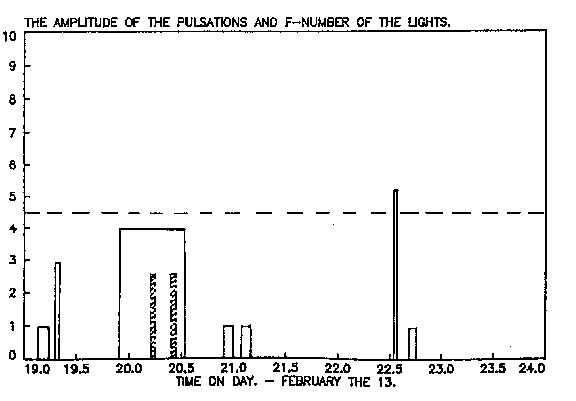
Fig. 3.6.3 - Recordings on 13 February
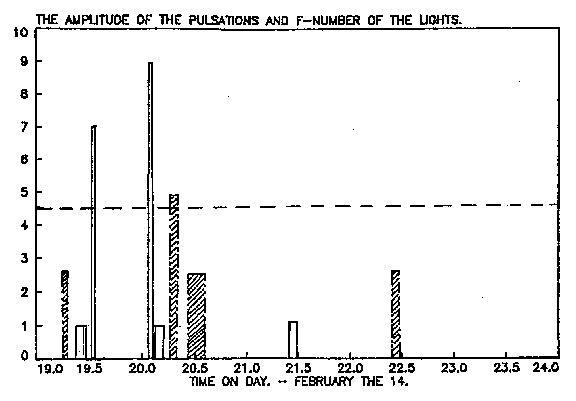
Fig. 3.6.4 - Recordings on 14 February
3.7 Laser
We used the laser, and pointed it towards a flashing light, in
two different cases, totally 9 times. 8 of these times, there
was a reaction.
In the first case, there was a regular flashing light, slowly
moving towards north, on Sunday 12 February at 7.35 pm. The
flashing had been regular all the time we had seen the light.
The light moved slowly. From the first time we saw it in the
south, until it disappeared in the north, it took about 15
minutes. When this light was in the northern part of
Finnsåhøgda, we pointed the laser towards it for the first
time. At once, it changed the flashing sequence: From a
regular flashing light, it became a regular double-flashing
light:
Flash.Flash.......Flash.Flash.......Flash.Flash.......
After about 10 seconds, we put the laser down, at once it
became a regular single-flashing light again:
Flash......Flash......Flash......
After about 10 seconds we repeated this again. It was repeated
totally 4 times before it went out of sight. All the times, we
got this double-flashing, when the laser was pointing at it.
The second case, the same type of light came from the north
and moved towards south. It was the same day, Sunday 12
February at 8.41 pm. When the light was in the west, we
pointed the laser towards it. The same thing happened now; it
changed to a double-flashing light when the laser pointed
towards it. This time we did it 5 times. Only the last of
these times did we not get any double-flashing. But 4 of these
5 times, we got it.
The test was done like this: Kurt Persson used binoculars
looking at the light. He told what he was seeing all the time;
he said: "flash...flash...flash...". I (Erling Strand) used
the laser. He could not see where I was pointing with the
laser. When I raised the laser, pointing at the light, he
said: "flash.flash.....flash.flash.....flash.flash.....". May
Britt Pellving was a witness to what we were doing. There were
also other persons out at that moment, but they were
concentrating on their work.
3.8 Geigercounter
The geigercounters we used made a beeping sound every time
they made a measurement. They were functioning all the time,
but we could not hear any change in the counting rate during a
light observation. I have to point out that we never had these
lights close (less than 1 km) to the counters.
3.9 IR-Viwer
The two times we used the IR-viewers, we saw no strong IR-
radiation.
But we used it only on lights far away. The power from the
lights could have been too weak to be detected on our IR-
viewer. And since we used it only two times, it should be
clear that there is not enough material to draw any
conclusion.
3.10 F10-lights
I will now go through the reports which have got a score of
F10.
Monday 20 February at 6.12 pm: Red light
Maybe the most "unexplainable" happening was the red light on
the ground. It happened on Monday 20 February. Leif Havik was
alone in the caravan. He was dressing. Åge Moe (a farmer from
Hessdalen) and Edvin Kværnes (also from Hessdalen), had just
arrived. They waited outside the caravan. Moe at the north
side, beside the door into the caravan, and Kv'rnes at the
south side. They should all go into Øyungneset, to see the
lights from that place. Just when Leif went out of the
caravan, a red light moved around his feet and disappeared.
The duration was a few seconds. Moe said: "Look at the
reflection". That was the only explanation he could figure out
aat that time. Leif saw at once that it was the same type of
light as from our laser. The laser we had used was at that
time in Oslo.
To check if it really was the same type of light, as from our
laser, we brought the laser back on 25 February. Moe had never
seen a laser before. We brought him to the caravan. It was
about the same time of day when we did this checking. When I
put the light onto the snow, just beside our feet, Moe said:
"That's exactly what I saw! But it was a little bit weaker".
Then I put the light on the floor in the caravan, and he said:
"It was a little bit stronger than that".
What could make such a light on the snow. It was very strong.
What could it be? All the lights in the caravan had been
switched off before this happened. There were no lights
outside. It could not have been light from the houses. The
nearest house is about 500 meters away, and it is below a
hill. The nearest house you can see is 2 km away, in the
south. The light showed up on the northern side of the
caravan. All the houses you can see is on the southern side.
And if any of the inhabitants should have a laser (very
doubtful), probably the only place that person could have
been, was in an airplane with no engine and with no lights. -
We have not found any explanation on this light, and I don't
believe we will either. In the discussion, Leif said: "If I
only had put my hand above it, then I could have found out
where it came from. But I didn't think of that when I saw it".
A second after the light had been "switched off", they looked
up in the air, but nothing was seen. It was cloudy, but just
over the caravan, there was a little opening in the clouds,
and there did they see the stars.
Friday 17 February at 6.05 to 7.30 pm: Yellow light.
The report written by Ove Lövgren, from Hersjøen says:
"At 6.05 pm Ove Joakim Karlsson and Dick Ekenhage went up to
the observing place. They came from the cottage. When they
were 150 meters from the cottage, they saw a light on the west
side of Hersjøen. At 6.15 pm they made some filming and took
some pictures. At 6.25 pm they thought it was a cottage,
because it hadn't moved. Joakim thought he saw two flashes
from the light, but they went on up to the observing place. At
7.30 pm came a yellow light, which was two lights close
together, from the western part of Hersjøen. It went to the
northeast, but changed direction, and went right towards us.
We took photos. When Joakim called on the walkie-talkie, it
took a couple of seconds and the light burned out. The light
was about 600 to 1000 meters from us, when this happened.
Nothing more was seen, and no sounds could be heard, even when
it was close to us".
- When we study the local map, we see that there is 3 to 4 km
from the observing place to the mountain on the western part
of the lake Hersjøen. If they used that distance as a reference, it
might be correct the distance they indicated where the light
burned out. - It was the same light as Joakim and Dick saw
between 6.05 and 6.25 pm that moved at 7.30 pm. The report was
not clear on that point. They looked at this light often
during the time from 6.05 to 7.30 pm. - The film they took
show only a moving light. No other reference is in the movie.
Then we can't be sure if the movement is caused by the light
movement or movement of the camera.
All this together made it an F10-light.
Thursday 2 February at 8.11 pm: A bright "object".
This was the same type of light which has been photographed
earlier (see fig. A7). It was three separate lights moving
towards north, just above the mountain Finnsåhøgda. It seemed to be quite
near. The distance to Finnsåh&slash;gda from the observing place is
about 1500 meters. The distance to the light was about 2 - 2.5
km. The observers could see these three bright lights. They
indicated also that they could see a darker area in between
the bright lights, and also smaller and weaker white light.
The movement of the three bright lights was so that it seemed
to be fixed onto one "object". Two of them was yellow-white
lights and they seemed to be in the back, and a red one seemed
to be in the front.
These lights were moving over the mountain Finnsåhøgda towards the eastern
part of Litlfjellet. They seemed to be near and just over the
mountain. When they were over Litlfjellet, they seemed to be
in the same height as the top of Litlfjellet. They had, what
the observers called; a waving movement.
At this time, there were none at the headquarter. That is why
no instrumentation reading could be done. The lights were
observed from Jon Aspås' house at Aspås. Leif havik had a
coffeebreak at Jon Aspås, when Åge Moe phoned and told about
the light which was coming. He called at 8.11 pm. Just after
that, Lars Lillevold called and said the same thing. Åsmund
Aspås and Johannes Lyngstad were also at Jon's house. Edvind
Kværnes was at Åge Moe. They all went out, and Leif took a
camera equipped with a 400 mm telephoto lens. He took some
pictures. These pictures were not successfull, because there
was no tripod. You can only see a light moving all over the
pictures. This movement or smearing is due to the camera
movement. The time from Leif Havik saw the light over
Finnsåhøgda and until it went out of sight at Litlfjellet, was
between 1.5 and 2.5 minutes. Jon A. Aspås and his children had
also seen it from Heggset.
Friday 27 January at 10.58 pm: A bright light.
Just after a plane was observed, moving towards north, a
bright light was seen through binoculars over Brattbekken on the mountain
Finnsåhøgda. Jon Aspås and Ruth Marry Moe were observers. Leif
Havik was looking at the radar screen. The observers saw the
light move at a great speed to the northwest. At that moment,
Leif Havik saw two following echoes on the radar. The distance
between the two echoes was about 20370 +/- 1000 meters. The
time between them was 2.4 seconds. That give a mean speed of
about 8000 to 9000 m/s.
Just after Leif had seen the echoes, he went outside. Then the
observers told that they had just seen a light moving at a
great speed from south to northwest over Finnsåhøgda.
Their indication of the speed, direction of motion and time
seemed to coincide with what Leif Havik observed on the
screen. The accuracy of time was about 2-3 seconds.
4. DISCUSSION
- What have we learned and what should we have done
differently?
4.1 The sightings
Totally we have reports on about 188 sightings. That includes
the reports that were written on planes too; 86. There were of
course more planes totally during the project period, but none
had written any report on the others.
If you study the summary of the reports, in the appendix, and
study the timetable of the planes, you might say that more
reports should have a higher "F-score". This is probably
right, but the reason why they haven't got any higher score,
is that many of them did not look as anything unknown.
If we had got a direct line to the radar station that covers
the district, we could perhaps have picked out the planes
easily. That means that we would have got few reports with a
score between F2 and F8. And then we would have got a more
correct picture of the unknown light: When and where. The line
to the radarstation will probably be "connected" in a future
project period. All recordings on planes moving to V'rnes
airport (200 km to the north) can then be noted. And if we
together with this could register all planes that we can see,
we could easily pick out the planes afterwards.
It is also important that we take measurements of all lights
that we are not 100% sure is a known light. We once had a very
good opportunity to make measurements; take spectral pictures
of an F10-light; the one at 6.05 pm on Friday 17 February. But
the reporters "thought" it was a cottage. After it started to
move, they became sure that it was no cottage light, but it
was too late to make any good measurements.
We must be more clever with the documentation of the photos.
Some of the best pictures did not agree completely with the
report. The observers should have taken reference pictures
that couldn't have been mistaken. Even though this can be made
better, and it will this winter, we have many documented
pictures of the lights.
We did not have a continuous watch on all stations. So the
fact that we have less reports before 11 February and in the
last time of the period, is mainly because of lack of
personnel.
4.2 The spectral analysis
Many of the spectral films had too much noise; higher order
spectra from known lights. If we had built a special screen on
the cameras, this type of noise could have been avoided. That
is, we could have had more spectral pictures. We have learned
from this mistake, and I hope that we will succeed in taking a
spectral picture of an F10-light next time.
We only got four spectral pictures out of seven films, mainly
because we didn't use this screen, and because the exposure
time on the cameras sometimes was too short, and because the
light sometimes moved too fast.
Next time we will have this screen. If we also could have a
light amplifier on some cameras, the probability of taking a
good spectral photo will increase.
4.3 The radar and spectrum analyser
We did not manage to watch the radar and spectrum analyser
screens all the time. That means that it might have been more
registrations on these than we have noticed. That's mainly due
to lack of personnel.
Next time we should have instruments that could record every
change on the screen. This should be possible with a spectrum
analyser. But radar equipment with this possibility is
difficult to obtain. If we don't get this, we should stress
that more people should be at the main station.
4.4 The magnetometer
When we analyse the recordings afterwards, and find that
probably no connection exists with the slowly varying
magnetical fluctuations, only the pulsations, we can say that
it is a pity that we didn't have a pulsation magnetometer, and
that we didn't have the TOA-recorder all the time. Next time,
we know that this is the main issue to stress on the
magnetical part.
4.5 The laser
The results from the laser test are very surprising. Even
though we have heard that one person have done a light test
before and succeeded, I personally thought that this test was
only a coincidence. But we did also get a result, 8 out of 9
times. We could have done this test more times. And I think we
will another time. Maybe even a stronger laser?
4.6 The geigercounter and the IR-viewer
Even if we didn't register anything on these instruments, I
think we should have them with us another time.
We didn't have any lights close to the station. If we have had
that, maybe there had been a recording? The IR-viewer we only
used twice, and I have already mentioned that this is not
enough to draw any conclusion.
4.7 The "nonworking" instruments
Many times during the project period, the cameras failed. This
happened mostly when we needed them most. Such happenings
should also have been registrated. Even some of the other
instruments failed when we needed them most, mainly because of
bad power connection. All such events should be recorded.
5. CONCLUSION
What is this phenomenon? What do we know about it?
We have not found out what this phenomenon is. That could
hardly be expected either. But we know that the phenomenon,
whatever it is, can be measured.
Beside the light measurements, it can be "measured" by radar
and laser. Perhaps the measurements we did on the magnetograph
and spectrum analyser are due to this phenomenon as well. We
have to do more measurements with these instruments, before we
can be sure of that.
We got no measurements with the geigercounter, seismograph or
IR-viewer. But I will prefer to bring these instruments as
well in the next period. And it might be useful to also record
events that seem to be unimportant. We stand in front of
something unknown, and we must collect everything that might
lead us to an answer on what this is.
Some hypotheses of what this phenomenon is, might be weakened
or strengthened after analysing the measurements in this
report. However, the different hypotheses will not be
discussed here. The report is more intended to set a basis for
further discussion on what it can be, and what should be used
in the nest period.
Erling Strand (sign.)
5 January 1985.
- REFERENCES.
1. "UFO" no. 1, 2, 3, 4, 5; 1982. 1, 3, 4, 5; 1983. 1, 2, 3,
4/5; 1984 (ISSN 0800-1758)
2. Project Hessdalen Bulletin. No. 1, 2, 3; 1983. 1, 2 1984.
3. "Fotogeologisk analyse av området Hessdalen - Øyungen" -
by Dr.sc.nat. Michael Heim.
4. Preliminary Bedrock Map 1:250 000. Røros NP31, 32-8.
NGU 1981 by F. Chr. Wolff.
5. Aeromagnetisk Kart. Haltdalen-1620I, Vangrøftdalen-1620II.
NGU 1965
6. Registreringskart: Malmforekomster. Røros.
NGU 6-74 by J. Gust.
7. Letter from Jernbeton A/S. Date 9/12-83, by Per Inge
Henriksen.: Overview of the explosions on Brattset and
Ulset powerstations.
8. Geology of the R&slash;ros district, southeastern Trondheim
region with a special study of the Kjøliskarvene-
Holtsjøen area. - by Ingolf J. Rui. Institutt for
Geologi. University of Oslo. Published in: Norsk
Geologisk Tidsskrift, Vol. 52, pp. 1-21. Oslo 1972.
9. Reports, notes from Hessdalen.
10. Maps:
- Series M711 Edition 2 TPC. Sheet 1620 I. Haltdalen.
- Series M711 Edition 2 NOR. Sheet 1620 II. Dalsbygda.
- Series M711 Edition 2 TPC. Sheet 1720 IV. Ålen.
- Series M711 Edition 2 nor. Sheet 1720 III. Røros
NGO 1971
11. Project Identification: The first Scientific Study of UFO
Phenomena. Prentice-Hall 1981 ISBN 0-13-730713-6
by Ph.D. Harley D. Rutledge
12. "Earth Lights". Turnstone Press, 1982
by P. Devereux
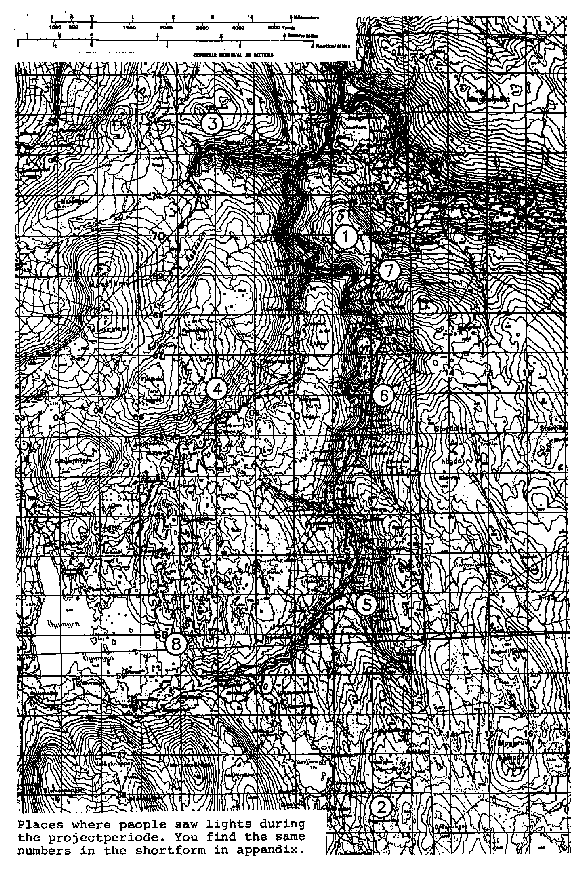
Places were people saw lights during the project period. You
find the same numbers in the summary in the appendix.
A P P E N D I X
A1. Summary of the reports
The reports are either a separately written report, notes on
tape, or notes on paper. If there is no space between two
reports in this list, is it the same light that is reported in
two or three reports.
The summary of the reports will be written as following:
Hour.Minutes: Place; Category; Story......
Film name, no. ; .....Story.
The place is:
- (1): Aspåskjølen
- (2): Hersjøen
- (3): Litlfjellet
- (4): Finnsåhøgda (south)
- (5): Kjerrengvoll
- (6): Heggset
- (7): The intersection where the road from the headquarter
leads out to the main road
- (8): Øyungen
The category is:
F: Indicate how difficult it will be to find an explanation
for the light. F1 marks with a hundred percent certainty that
the light is known; i.e. an aeroplane. F10 marks that no
explanation is found.
G: Indicate how good the report is. If the report contains
many details, or if it contains details enough to get a
satisfactory explanation, it will get a G9 or G10. If the
report contains very few details, it will get a G1.
Saturday 21 January.
17.33: (5); G6,F1; A plane towards north.
17.45: (5); G7,F6; A yellow-white light showed up in the
direction of the mountain Rødhovde. Sometimes it flickered with uneven
frequency and uneven amplitude. It had an irregular movement.
It moved towards the north over Finnsåhøgda and disappeared
from sight at 17.48 pm.
17.50: (1); G7,F8; A red light to the north. Recording on
radar.
ES1/1-3
18.03: (5); G7,F6; A light showed up over Finnsåhøgda. It
moved towards southwest. It was flickering. When it was over
Fjellbekkhøgda, we saw that there were two lights. They were
about 10 degrees apart. The last one was a little bit weaker.
They moved in this way some minutes. Then, the last one moved
up 10 degrees, and disappeared a short time after. The
flickering was uneven. In between the strong flickering, there
were several (weak) flickerings. The bright one continued
towards southwest, and became weaker (longer distance). Just
before it went out of sight, it stopped flickering, made a big
jump, and started to flicker again. It went out of sight at
18.17.
OGR/1
18.10: (1); G4,F4; Flashing light in southwest.
ES/4
19.20: (1); G6,F7; Light with strange "jumps" in southwest.
This jumping stopped suddenly, and it moved towards north.
Sometimes there were strange movements, but not with any big
amplitude. While it was seen in the north, it first slowly
started to oscillate and suddenly made a big movement, like an
"S", up in the air and disappeared. This happened at 19.30.
RW/2,3
ES1/11,12,13,14
OGR/2-10
19.26: (1); G3,F1; Plane towards south.
RW1/5
19.40: (1); G5,F4; Light in the southwest, moving towards
north. Duration about two minutes.
ES1/18
21.20: (1); G2,F3; Flickering light in southwest.
OGR/11
Sunday 22 January.
01.50: (1); G2,F3; Flickering light over Finnsåhøgda.
OGR/12,13
17.45: (1); G2,F2; Bright light moving towards north. (Plane?)
19.20: (1); G2,F3; Flickering light just above Litlfjellet. It
moved towards north. It disappeared at 19.25.
OGR/14
19.45: (1); G2,F2; Light moving towards north. Strange
movement.
OGR/17-19
Tuesday 24 January.
19.15: (4); G6,F4; Light in the east, with unregular
flickering. It moved towards south.
APT/3
19.20: (4); G6,F7; Many white lights with a big flashing red
light, came from the north, turned around "Fjellbekktoppen",
and moved towards north.
APT1/4-12
19.40: (4); G6,F1; Plane towards north.
APT1/13-15
Wednesday 25 January.
17.32: (1); G6,F8; Big "object" from south. Unregular white
and red lights. Radar contact. Two echoes. (See separate radar
report.)
17.41: (1); G6,F1; A plane over the station, moving towards
north.
18.24: (1); G6,F1; A plane moving towards south.
18.40: (1); G6,F1; A plane moving towards north-northeast.
19.05: (1); G6,F1; A plane moving towards north-northeast.
19.10: (4); G7,F6; A yellow light, as bright as Venus, stood
motionless a couple of minutes in southwest, 20 degrees over
the horizon. Suddenly it started to move towards north, in the
west. "Just after I had taken three photos with the camera
(with grating), it suddenly speeded up and disappeared behind
Fjellbekkhøgda".
APT1/22-24
19.16: (1); G5,F4; A yellow-red light moved towards north over
Finnsåhøgda.
LH1/
19.35: (1); G6,F1; A plane moving towards south.
20.12: (1); G6,F1; A plane moving towards south.
20.12: (1); G4,F6; A red flickering light moving towards the
north, in the west. It moves down, when it is in the north.
20.54: (1); G6,F1; A plane moving towards south.
21.53: (1); G6,F1; A plane moving towards south.
22.00: (1); G6,F1; A plane moving towards north.
22.43: (1); G6,F2; A plane? moving towards north. No sound.
23.21: (1); G7,F1; A plane moving towards south.
Thursday 26 January.
22.47: (1); G4,F5; A bright light with a red light in front,
moving towards north.
Friday 27 January.
22.53: (4); G2,F1; Plane.
22.56: (4); G5,F6; The big light (as a jumbojet) moved in the
same course as the plane, but a little bit slower and lower.
22.58: (1); G9,F10; A bright light moving from south to north.
It showed a large speed. This light was also registered on
radar. The radar measured a minimum speed of about 8000 to
9000 m/s. See separate radar report.
Sunday 29 January.
17.31: (1); G3,F4; A light moving towards north.
Tuesday 31 January.
22.48: (1); G3,F4; A light mowing towards north.
Wednesday 1 February.
13.59: (1); G9,F1; Two small planes coming from Rognefjell,
moving north. They were seen on the radar.
Thursday 2 February.
20.11: (1); G7,F10; A bright "object" moving towards north. It
has two yellow-white lights, and it is darker in the middle.
It has a red light in the front. The movement was "waving". It
was near and low, just over Finnsåhøgda, and it moved towards
the eastern part of Litlfjellet.
Friday 3 February.
23.02: (7); G2,F6; A light just over the headquarter, moving
up and down.
Sunday 5 February.
23.00: (1); G3,F4; A light moved straight down in the southern
part of Finnsåhøgda.
Tuesday 7 February.
20.11: (1); G3,F4; A bright yellow light with a flickering red
light, moving towards north.
22.47: (1); G3,F3; A light moving towards north.
Wednesday 8 February.
19.53: (1); G2,F4; A yellow light moved straight down, west of
Litlfjellet.
Saturday 11 February.
18.44: (1); G6,F3; A light moved straight down between the two
lowest stars in Big Dipper.
19.20: (2); G7,F5; A yellow light moving towards north. It was
seen in the west.
H001/1,2
19.21: (1); G8,F5; A yellow light with a flickering red light,
moving from southwest to northeast. It went out of sight at
19.25.
LH1/12-18
21.04: (2); G8,F1; A big light in the sky. Probably a
reflection. It disappeared at 21.17.
DM001/3
21.20: (2); G5,F2; A big weak light on the mountain. Probably
reflection? It disappears at 22.40.
23.10: (2); G5,F2; Light in the sky. Reflection?
23.27: (1); G2,F9; A yellow-orange light in the east. The
mountain is seen behind the light. It moves up and down.
Sunday 12 February.
18.18: (1); G2,F2; Plane (?) towards south.
18.29: (1); G2,F2; Plane (?) towards south.
18.35: (2); G5,F4; A yellow-orange light moving towards south.
H001/4-8
18.39: (1); G2,F2; Plane (?) towards south.
18.41: (1); G1,F2; Two planes (?)
19.02: (2); G7,F5; A red light in the north, just over the
horizon, moving towards west. Duration 1 minute.
H001/9,10
19.13: (1); G2,F1; A plane.
19.20: (1); G7,F8; A red flickering light in the south, moving
towards the north.
19.22: (2); G7,F8; The light meets a plane (G3,F2), that
travels towards south.
19.25: (2); G7,F8; Bright light in the west, moving towards
north.
19.35: (1); G7,F8; A red flickering light just over
Finnsåhøgda. The first test with laser. Reaction! Four out of
four tests.
19.52: (1); G2,F2; Plane moving from north towards south.
ES2/10
19.55: (2); G5,F3; Light in the west, moving towards south.
19.55: (1); G3,F4; A red "double-light" in southwest.
20.40: (1); G4,F1; A plane moving towards south.
20.41: (1); G6,F8; A flickering light moved from the mountain Litlfjellet
to the mountain Finnsåhøgda. It moves down in the southern part of
Finnsåhøond test with laser. Reaction! Three out of
four tests.
21.53: (1); G8,F5; Plane towards north.
LH1/19-23
22.48: (1); G8,F5; A light moving towards north.
LH1/24-28
22.50: (2); G5,F5; A yellow light moving towards north.
Duration two minutes.
H001/15,16
22.52: (1); G5,F5; Light moving towards north.
23.39: (2); G6,F6; Yellow light moving towards south. Duration
30 seconds.
Monday 13 February.
00.30: (5); G1,F7; A big light over Hersjøen. It stood still
for a couple of minutes. Then it moved fast towards northwest,
and stopped over Øyungen.
17.58: (1); G8,F1; A plane moving towards south.
18.02: (1); G4,F2; A satellite moving towards northeast.
18.19: (1); G8,F1; A plane moving towards south.
19.18: (1); G8,F1; A plane moving towards south.
19.39: (1); G4,F3; A light moving fast down on the
mountainside. Reflection?
19.55: (2); G7,F4; An orange light "lay" on the edge of the
mountain in northwest, for 40 minutes.
20.56: (1); G8,F1; A plane moving towards south.
21.05: (1); G8,F1; A plane moving towards north.
22.35: (2); G8,F6; An orange light in the south, 10 degrees
over the mountain. It turned out after 10 seconds.
22.42: (1); G3,F1; A plane.
Tuesday 14 February.
06.07: (2); G8,F2; A white light moving upwards, in the west.
Duration 4 seconds.
13.40: (1); G2,F1; A plane.
16.54: (1); G8,F1; A plane moving towards north.
18.08: (2); G7,F1; A flickering light in southeast, 10 degrees
over the mountain. - A star.
H002/3,4
19.22: (1); G4,F1; A plane moving towards north.
19.29: (1); G3,F1; A plane moving towards north.
19.32: (1); G2,F7; Three flashes in the southeast. First weak,
then stronger and the last one very strong.
20.06: (1); G2,F9; Some flickering, in a short time, just by
Hammerkneppen (?), in the north. It seemed to be very close to
the headquarter.
20.12: (1); G8,F1; A plane moving towards north.
21.24: (1); G6,F1; A plane moving towards south.
Wednesday 15 February.
13.30: (1); G9,F1; A private plane moving towards south, on
the east side of the station. Also registered on radar.
16.44: (1); G8,F1; A private plane moving towards south, on
the east side of the station.
18.49: (1); G2,F6; A red flickering light moving towards
north.
18.55: (1); G2,F6; A red flickering light moving towards
north.
19.12: (1); G8,F1; A plane moving towards north.
19.28: (1); G3,F6; Red flickering light moving towards west,
in the northern part of Litlfjellet.
19.30: (2); G6,F4; A yellow light moving towards north, in the
west. It went out of sight at 19.38.
19.46: (2); G6,F6; A red unregular flickering light, moving
towards north, in the west. 25 to 30 degrees over the
mountain. It ended/went out of sight at 19.52.
H002/5
19.54: (2); G6,F6; A red unregular flickering light, moving
towards north. 20 degrees over the mountain. It ended/went out
of sight at 20.06.
H002/7
20.21: (2); G7,F7; A red flickering light, moving from the
north to the south. It met a yellow light, which went over the
red one. The red light was seen for 8 minutes, the yellow for
4 minutes.
21.00: (2); G8,F5; A yellow light, moving from the northwest
to the southeast. 25 degrees over the mountain. It went out of
sight at 21.12.
H002/19
21.05: (1); G8,F5; A yellow-white-red light moving from
northeast to southwest. It went out of sight at 21.08.
LH1/31,32
22.00: (1); G8,F1; A plane moving towards south.
22.06: (1); G8,F1; A plane moving towards north.
22.46: (1); G8,F6; A big oval light, with a darker area in the
middle, moving from the south to the north, over Finnsåhøgda
and west of Litlfjellet. It moved very low.
LH2/00-1
23.15: (1); G8,F1; A plane moving towards north.
Thursday 16 February.
18.26: (2); G8,F1; A yellow light in the west, moving towards
south.
H002/21,22,23
18.26: (1); G8,F1; A plane.
19.33: (2); G7,F4; A yellow light in the west, moving towards
north.
H002/24-27
19.34: (1); G7,F4; A light moving towards north.
19.45: (2); G4,F7; 5 or 6 red flashes in the west, moving
towards south. 5 seconds.
19.46: (1); G4,F7; 5 red flashes in the south.
20.10: (1); G7,F4; A light moving from the south to the north.
It was seen until 20.14.
LH2/3-7
20.12: (2); G7,F4; A yellow light in the west, moving towards
north.
H002/28,29
20.35: (1); G8,F1; A plane moving towards south.
21.00: (1); G8,F1; A plane moving towards south.
LH2/8
21.01: (2); G8,F1; A yellow light in the west, moving towards
south.
H004/2-5
21.24: (2); G7,F6; A red light in the west, moving towards
south. 40 degrees over the mountain. Duration 3 minutes.
H003/3,4
21.53: (1); G8,F1; A plane moving towards south.
21.59: (2); G7,F4; A yellow light in the west, moving towards
north. 10 degrees high. Duration 3 minutes.
H003/3,4
22.21: (1); G2,F6; A light moving towards south.
22.42: (1); G8,F1; A plane moving towards north.
22.58: (1); G8,F6; A big light moving towards north in the
west. It went out of sight at 23.01.
LH2/9-15
23.12: (1); G8,F1; A plane moving towards north.
23.26: (2); G6,F4; A strong white light moving upwards, from
north to south. Duration 2 seconds.
Friday 17 February.
17.15: (1); G2,F1; A plane
17.33: (1); G4,F1; A plane moving from north to south.
17.47: (1); G4,F1; A plane moving from south to north.
18.04: (1); G2,F1; A plane.
18.05: (2); G9,F10; A yellow light was observed in the
mountainside, on the western part of Hersjøen. We took some
pictures. But as it hadn't moved until 18.25, we thought it
was a light from a cottage. A couple of times it seemed as if
it was flickering, otherwise it was stable. At 19.30 the light
suddenly started to move out in the valley, direction
northeast. Then we could see that there were two lights,
placed very close to each other. Shortly afterwards, it
changed direction, and moved straight towards us (in the
south). One of us tried to call up the headquarter on a
walkie-talkie (27 MHz). Just a few seconds after that, the
lights "burned out". The distance to the lights when this
happened, was about 600 to 1000 m. The time elapsed from it
started to move until it "burned out", was about 1 minute 30
seconds.
18.44: (1); G2,F1; A plane.
19.13: (1); G2,F1; A plane.
19.37: (1); G8,F1; A plane moving from north to south.
20.23: (1); G8,F1; A plane moving towards south.
23.02: (1); G8,F1; A plane moving towards north.
23.37: (1); G8,F1; A plane moving towards north.
Saturday 18 February.
18.29: (2); G7,F2; Light in the mountain. Cottage (?).
18.36: (1); G8,F1; A plane moving towards north.
19.18: (1); G7,F5; A yellow-white light with a flash, moving
towards north. Duration 2 minutes.
19.21: (1); G7,F5; White flickering light moving towards
north.
20.18: (1); G8,F7; A strong light, just over the horizon in
the east. Slowly moving horisontally to the south. It was
slowly "flickering": It gradually became very strong, and when
it gradually became very weak. Again it became strong and weak
and strong... This happened about five to six times. Each time
we managed to take a picture. These pictures have a very good
quality, compared to what we could expect under such
circumstances. It ended at about 20.20.
RW1/13-17
22.01: (1); G3,F4; A flash at the top of Finnsåhøgda.
23.21: (3); G8,F1; A plane moving towards south.
23.22: (1); G8,F1; A plane moving towards south.
Sunday 19 February.
17.38: (1); G4,F2; A plane (?) moving towards north, east side
of the headquarter.
LH3/4
19.18: (3); G5,F1; A plane moving towards north.
19.22: (1); G5,F2; A red-yellow light on the western part of
Litlfjellet.
LH3/5
19.25: (1); G8,F5; A light moving towards north, over
Finnsåhøgda and west of Litlfjellet. It went out of sight at
19.28.
LH3/6-10
19.27: (2); G8,F1; A plane moving towards north.
19.42: (1); G8,F1; A plane moving towards south.
20.05: (2); G3,F5; A small yellow-white light in the north-
northwest. It stood motionless for 1 minute.
20.05: (2); G3;F5; First a light in north. Just afterwards; a
flickering light towards north.
20.09: (1); G5,F3; A light moving towards north. A bright
white flickering. It went out of sight at 20.16.
LH003/11,12,15,16
20.11: (1); G5,F4; Red and green light moving towards north.
LH003/13,14
20.13: (3); G8,F1; A plane moving towards north, in the west.
20.20: (1); G8,F1; A plane moving towards south.
20.20: (3); G8,F1; A plane moving towards south.
20.24: (1); G8,F7; A light just over the horizon in the east.
It behaved just like the light the day before; the one at
20.18.
LH3/17,18
21.25: (2); G3,F1; A plane moving towards south.
21.26: (1); G4,F5; A red light with a white flickering light,
moving towards south.
22.09: (3); G3,F1; A plane moving towards north, in the west.
22.45: (2); G8,F7; A strong white light, with a red light in
front, moving towards north. 35 degrees over the mountain. It
went out of sight after 3 minutes.
22.48: (3); G8,F7; A red light and a strong white light moving
towards north, in the west. Low over the horizon.
22.49: (1); G8,F7; A strong light with a red flickering light,
moving towards north.
LH3/21
22.51: (3); G8,F1; A plane moving towards south.
22.53: (1); G8,F1; A plane moving towards south.
Monday 20 February.
05.17: (1); G8,F1; A plane with a white flickering light,
moving towards south.
18.12: (1); G7,F10; A strong red point moving around on the
ground.
18.25: (2); G3,F1; A plane moving towards south.
18.30: (2); G7,F4; Two small red lights moving up the
mountainside on Skarvan. They were three centimetres apart
(relative dimensions, viewed at an arm's length), moving
exactly parallel. It took the lights 30 seconds to "climb up"
the mountainside.
18.41: (2); G2,F2; A small white light in the mountainside, in
the direction of Fjellbekkhøgda.
18.45: (2); G2,F2; A white light moving down the mountainside,
in the direction of Rødhovde.
19.22: (2); G5,F5; A yellow-orange light in the west, moving
towards north.
19.24: (8); G5,F5; A light moving towards north, just above
Øyungen.
19.58: (8); G8,F1; A plane moving towards south.
20.07: (2); G7,F4; A light moving very fast towards north. 35
degrees over the mountain, in the west. Duration 3 minutes.
20.08: (8); G7,F4; A light moving towards north. 60 degrees
over the mountain, in the west.
20.09: (8); G7,F4; Three flashes very high up, in the east.
20.09: (2); G7,F4; Some flashes in the zenith (elevation 90
degrees).
21.54: (8); G8,F1; A plane moving towards south.
22.21: (8); G8,F1; A plane moving towards south.
22.48: (8); G8,F1; A plane moving towards north.
Tuesday 21 February.
19.41: (3); G1,F2; A plane (?).
Wednesday 22 February.
18.38: (3); G6,F1; A plane moving towards north.
19.13: (3); G2,F1; A plane moving towards north.
20.13: (1); G3,F5; A red light moving towards north.
20.14: (1); G8,F1; A plane moving towards south.
20.15: (3); G8,F1; A plane moving towards south.
22.23: (1); G8,F1; A plane moving towards south.
Thursday 23 February.
09.43: (1); G9,F1; A military plane moving towards northeast.
09.50: (1); G8,F1; A mil. plane moving towards north.
10.04: (1); G9,F1; A mil. plane moving towards northwest.
10.08: (1); G8,F1; A plane moving towards south.
11.54: (1); G8,F1; A plane moving towards north.
12.11: (1); G8,F1; A plane moving towards north.
14.46: (1); G8,F1; A mil. plane moving towards north.
22.15: (1); G8,F1; A plane moving towards north.
22.19: (1); G8,F1; A plane moving towards south.
23.37: (1); G9,F1; A mil. plane moving towards north.
Saturday 25 February.
18.37: (1); G8,F1; A plane moving towards north.
20.06: (1); G3,F4; A flash just over Vårhuskjølen.
Sunday 26 February.
03.08: (2); G7,F5; First a flash, then a strong "spotlight"
pointing at the observers. Then the spotlight was directed
straight down. Thereafter the direction of the spotlight moved
upwards, and moved back to the observers once more.
A2. Overview on some of the films
In the summary of the reports, I have written down the
corresponding films. Not all of these were successfull. In
this list, I will shortly mention what you can see on the
films.
Lightst = A light that have made a line on the picture, due to
a long time exposure.
Fi = Finnsåhøgda
FiN = Finnsåhøgda north
Li = Litlfjellet
LiW = Litlfjellet west
LiE = Litlfjellet east
VaW = Vårhuskjølen west
Film: LH1. Type: Tri-X. Time: 8 February to 15 February
7 : A snowscooter by the cottage at Litlfjellet. 8 February.
8 : Leif sitting in a sledge, 8 Feb. at 14.00 o'clock.
9 : A spectral-picture of the moon (half-moon).
10: A spectral-picture of the moon.
11: Only two lights, that might be noise (?). Otherwise nothing.
12: A lightst over FiN.
13: A lightst over FiN, further north.
14: A lightst over Øggdalen.
15: A lightst over LiW.
16: A lightst over Li.
17: A lightst over LiE.
18: A picture of LiE, no lights are seen.
19: A lightst over VaW, with some weak flickering.
20: A lightst over FiS, with uneven (?) flickering.
21: A lightst over FiS, with flickering with uneven amplitude.
22: A lightst over Fi, with two strong flickerings, and some weak.
23: A lightst over Fi, with flickering with even frequency and uneven amplitude.
24: A lightst over FiN, weak and no flashing.
25: A lightst over FiN, further north, now strong and now flashing.
26: A lightst over FiN, weaker towards the end (north).
27: A weak lightst over FiN/Øggdalen.
28: A weak lightst (or noise) over Øggdalen, and Aurora.
29: No picture.
30: Aurora with no reference.
31: Two weak lights over Va, or is it noise?
32: A weak light over Va. The picture is probably taken at dawn.
Film: LH2. Type: Tri-X. Time: 15 February to 17 February.
00: A light over FiN. There seem to be something black in the picture. Is it noise?
0 : Light over Øggdalen. There seem to be two black "things" in the picture. Is this also noise?
1 : Øggdalen. No lights.
2 : Picture of Fi.
3 : Picture of FiN.
4 : A weak lightst over FiN.
5 : A weak lightst over FiN.
6 : A lightst over Øggdalen.
7 : A lights over Li.
8 : A strong flickering light over VaW.
9 : A light just over the horizon of Fi. Noise?
10: A double-flash high over Fi. Noise?
11: A weak lightst over FiN.
12: Øggdalen. No light is seen.
13: Litlfjellet. No light is seen.
14: Litlfjellet, and something which is long and black. Noise?
15: A lightst over LiE.
16: The station seem towards Rognefjell.
17: A dark "U" over Li. Noise?
18: A light without reference.
19: Nothing.
20: The moon.
21: The moon.
22: ---: Nothing.
Film: LH3. Type: Tri-X. Time: 19 February to 19 February.
0 : A snowscooter outside the cottage at Hersjøen.
1,2: Four people inside the cottage at Hersjøen.
4 : A daylight-picture towards northeast of the station.
5 : A lightst over FiN.
6 : A strong lightst over Fi. Weak reference.
7 : A strong lightst over FiN. Weak reference.
8 : A strong lightst further north.
9 : A strong lightst over Øggdalen.
10: A strong lightst over Li. A strange movement in the middle.
11: A flickering light over FiS. Weak reference.
12: A double-flashing light over Fi. Weak reference.
13: A double-flashing light over FiN. Flash-Doubleflash- flash...
14: The same type of light further north.
15: Uneven flickering light far away.
16: Nothing.
17: Two strong lights in the north.
18: One strong light in the north, and two weak ones, which might be noise?
19,20: A spectral-picture of the moon, in the east just above the horizon.
21: A strong lightst over Fi. Uneven movement and flickering.
Film: APT1. Type: Tri-X. Time: 24 January to 27 January.
0,1,2: Pictures of the nature in Hessdalen.
3 : Nothing.
4-16: Nothing.
17: A small lightst. It should be Sirius.
18: A strong light. Sirius.
19-21: Nothing.
22: A lightst. See a part of the spectrum. F=1.7, t=4 seconds.
23: A lightst. See a part of the spectrum. F=1.7, t=4 seconds.
24: A lightst. See a part of the spectrum. F=1.7, t=4 seconds.
25: A light with a strong spectrum: Sirius. F=1.7, t=8 seconds.
26: A light with a little bit weaker spectrum. T=4 seconds.
27: A light with a weak spectrum. T=2 seconds.
28: Only Sirius is seen. T=1 seconds.
29-33: Nothing.
34-37: Daylight-pictures of the nature.
Film: ES1. Type: Tri-X Time: 21 January to 22 January.
0 : A daylight picture of the nature.
1 : A short lightst over FiN. Good star-spectrum.
2 : A weak lightst over Li. Good star-spectrum.
3 : A weak lightst over LiE. Good star-spectrum.
4 : A lightst with flashing over FiS. Weak star-spectrum.
5,6: Nothing.
7 : A lightst with a strange movement over Va. The lights from the houses in Hessdalen and their spectras are also seen.
8 : A lightst with a strange movement and two flashes in the lightst. The lights from the houses and their spectras are also seen.
9 : Nothing.
10: A lightst with a flash. Good star-spectrum.
11: A double-lightst over Fi. First (in the south) weak with flashes, then strong. Good star-spectrum.
12: A double-lightst over FiN.
13: A double-lightst over Øggdalen. Strong with flashing.
14: A double-lightst over Li. The frequency of the flashing suddenly became higher.
15: Nothing.
16: Spectrum of the lights in Hessdalen.
17: Spectrum of the moon.
18: A strong light over Va.
19: A lightst over Li. Much more noise from the other spectras.
20,21: Daylight picture of the nature and the station.
Film: ES3. Type: Neopan 400.
1 : A weak light over Fi.
2 : A weak lightst over Fi.
3 : A weak lightst with uneven amplitude. No reference.
4-6: A weak lightst. No reference.
7 : Grey; nothing.
8 : Nothing.
9 : Two weak lightst over FiN.
10,11: Grey with some star spectras.
12--- Grey and nothing.
Film: RW1. Type: 2484.
3 : A lightst with a slowly growing oscillation in one end.
5 : A lightst.
13-17: A light moving horisontally in the northeast. Good pictures.
18: Only nature. A ref. to picture 17.
Film: X. Type: Tri-X.
1 : A picture of Øggdalen. Unclear in the front.
2 : A picture of Øggdalen. Unclear in the front. Two lights over Fi?
3 : A picture of Øggdalen. Unclear in the background.
4 : Two strong lightst with a strange movement over Fi.
5 : A strong lightst with a strange movement over Fi. Taken from Hammarkneppen?
6 : A lightst over Fi. Strange movement.
7 : A lightst over Øggdalen. Strange movement. One slight movement of the camera (?).
8 : A lightst over Li. Strange movement.
9 : A lightst over LiE. Strange movement.
10: A lightst over Hammarkneppen in north. Strange movement.
11: A weak lightst in the northeast.
12: A weak lightst in the northeast. Far away.
13: A weak lightst in the northeast. Far away.
14: A long lightst in the northeast. Strange movement.
15: A lightst over FiN.
16: A lightst over Øggdalen.
17: Nothing.
18,19: A lightst without reference.
20: Higher order mode of the spectrum from the moon (?), over Va. The spectrum is horizontal.
21: A daylight-picture of the station, seen towards FiS.
Film: H001. Type: Tri-X. Time: 11 February to 12 February.
1 : A light just on top of the mountain.
2 : A lightst with strange movements over the mountain.
3 : A big area in the sky which is lighter.
4 : Nothing.
5,6,7: A lightst with strange movement. No reference.
8 : A lightst over a tree.
9 : A picture of the mountain.
10-21: Pictures of some of the people in the project.
A3. Registrations on seismograph
During the project period, there were some recordings on the
seismograph. These recordings were sent to the University of
Bergen for analysis. They found out that all recordings came
from seismological activity far from Hessdalen, even from
other parts of the world.
We also took an overview of the recordings, and we could
clearly read visuable recordings at these times: (No
recordings from other times than during the project period,
are in this list)
01 Feb. at 08.00 - a small recording
01 Feb. at 15.42 - a small recording
12 Feb. at 06.01 - a small recording
15 Feb. at 11.57 to 12.00 - a small recording
16 Feb. at 18.26 to 18.42 - a big recording
18 Feb. at 00.14 - a very small recording
18 Feb. at 00.15 - a very small recording
18 Feb. at 00.34 to 00.37 - a small recording
18 Feb. at 06.31 - a very small recording
22 Feb. at 06.30 - a very small recording
23 Feb. at 16.31 - a small recording
24 Feb. at 13.59 to 14.03 - a medium recording
Recordings within a radius of 50 km from Hessdalen:
Mn=Month, D=Date, Hr=Hour, Mi=Minute, Se=Second, T= Type of registration (L=Local earth quaked,LE=Local explosion, LP= Not shure what it is)
km= Depth in kilometer, No= Number of stations som that have made the record. Q=Quality on the record. Small number is good quality.
Lm = Local magnitude (Richters skala), Cm= Coda magnitude
Recordings within a radius of 50 km from Hessdalen
| Year | Mn | D | Hr | Mi | Se |
T | Long. | Lat. | km | No | Q | Lm | Cm |
| 1887 | 01 | 22 | 04 | 27 | 0.0 | | 63.200N | 10.300E | 0 | | | 2.2 | |
| 1887 | 01 | 23 | 04 | 27 | 0.0 | | 63.100N | 10.500E | 0 | | | 2.5 | |
| 1900 | 02 | 08 | 21 | 15 | 0.0 | | 63.300N | 10.200E | 0 | | | 3.5 | |
| 1900 | 02 | 08 | 21 | 15 | 0.0 | | 63.300N | 10.200E | 0 | | | 2.1 | |
| 1910 | 05 | 18 | 01 | 24 | 0.0 | | 62.900N | 11.100E | 0 | | | 2.2 | |
| 1910 | 05 | 18 | 01 | 24 | 0.0 | | 62.900N | 11.100E | 0 | | | 2.1 | |
| 1953 | 06 | 19 | 00 | 00 | 0.0 | | 62.920N | 11.510E | 0 | | | 2.2 | |
| 1953 | 06 | 19 | 06 | 15 | . | L | 63.0 N | 11.7 E | . | . | . | 4.0 | 4.0 |
| 1964 | 03 | 28 | 03 | 10 | 0.0 | | 62.600N | 11.000E | 0 | | | 0.0 | |
| 1965 | 09 | 13 | 00 | 09 | 30.0 | | 62.900N | 11.300E | 0 | | | 2.0 | |
| 1968 | 01 | 10 | 06 | 57 | 29.0 | | 63.000N | 10.400E | 0 | | | 3.0 | |
| 1980 | 12 | 08 | 07 | 35 | 46.0 | | 63.300N | 10.600E | 0 | | | 2.4 | |
| 1982 | 05 | 21 | 21 | 12 | 6.0 | | 63.100N | 10.200E | 0 | | | 1.5 | |
| 1982 | 10 | 10 | 18 | 9 | 4.9 | L | 63.206N | 10.219E | 12.1 | 6 | 0.4 | 1.6 | 1.6 |
| 1986 | 03 | 18 | 14 | 57 | 14.5 | L | 62.581N | 10.437E | 0.3 | 3 | 4.8 | 2.1 | 1.2 |
| 1986 | 10 | 03 | 16 | 16 | 9.9 | L | 63.136N | 10.997E | 23.0 | 2 | 0.7 | 1.9 | 1.9 |
| 1986 | 10 | 31 | 14 | 0 | 15.1 | L | 63.274N | 10.326E | 0.1 | 3 | 1.0 | 1.7 | 1.6 |
| 1986 | 11 | 05 | 13 | 57 | 13.1 | L | 63.256N | 11.139E | 12.2 | 3 | 0.3 | 1.8 | 1.7 |
| 1987 | 06 | 02 | 14 | 29 | 43.5 | L | 63.243N | 10.550E | 15.0 | 3 | 0.8 | 1.9 | |
| 1987 | 06 | 10 | 15 | 43 | 0.2 | L | 63.247N | 11.334E | 0.0 | 3 | 0.5 | 2.0 | |
| 1987 | 09 | 01 | 16 | 29 | 30.5 | L | 63.002N | 10.982E | 13.5 | 3 | 0.2 | 2.4 | |
| 1988 | 03 | 03 | 16 | 14 | 42.5 | L | 63.266N | 10.672E | 12.1 | 2 | 1.5 | 2.2 | |
| 1988 | 05 | 11 | 15 | 31 | 17.9 | L | 63.186N | 10.341E | 12.2 | 2 | 0.5 | 1.8 | |
| 1988 | 10 | 14 | 15 | 40 | 34.5 | LE | 63.014N | 10.294E | 0.0F | 3 | 1.7 | 2.5 | 1.9 |
| 1988 | 10 | 31 | 14 | 59 | 53.4 | L | 63.263N | 10.441E | 0.1 | 4 | 1.5 | 2.5 | 1.4 |
| 1988 | 12 | 15 | 12 | 30 | 32.8 | LP | 62.942N | 11.235E | 0.0F | 3 | 0.8 | 2.4 | |
| 1989 | 02 | 23 | 14 | 50 | 6.7 | L | 63.284N | 10.300E | 0.0 | 2 | 4.5 | 2.2 | 0.5 |
| 1989 | 03 | 07 | 15 | 27 | 2.7 | LP | 63.116N | 11.637E | 0.0F | 3 | 0.9 | 2.0 | |
| 1989 | 05 | 19 | 12 | 45 | 39.5 | L | 63.208N | 11.383E | 15.0 | 2 | 0.6 | 2.2 | |
| 1989 | 06 | 01 | 14 | 32 | 55.2 | L | 63.276N | 10.839E | 20.9 | 3 | 0.6 | 1.9 | |
| 1989 | 07 | 04 | 20 | 48 | 59.5 | L | 63.285N | 11.131E | 5.8 | 4 | 0.4 | 1.9 | 1.0 |
| 1989 | 08 | 09 | 12 | 44 | 10.1 | L | 63.213N | 10.819E | 15.0 | 2 | 0.2 | 2.2 | |
| 1989 | 09 | 04 | 13 | 57 | 35.7 | L | 63.264N | 11.328E | 14.9 | 2 | 0.2 | 2.3 | |
| 1989 | 10 | 30 | 14 | 17 | 54.3 | L | 62.979N | 10.355E | 0.0 | 3 | 0.6 | 1.9 | 1.1 |
| 1989 | 12 | 14 | 14 | 25 | 27.7 | L | 62.967N | 10.392E | 0.0 | 4 | 0.7 | 1.6 | 1.3 |
| 1990 | 01 | 18 | 13 | 28 | 30.7 | L | 63.021N | 10.381E | 3.6 | 3 | 0.3 | 1.5 | |
| 1990 | 02 | 01 | 14 | 13 | 10.2 | L | 63.105N | 10.400E | 0.0 | 2 | 0.9 | 1.8 | 0.1 |
| 1990 | 11 | 01 | 15 | 01 | 34.9 | L | 63.170N | 11.393E | 12.1 | 4 | 0.8 | 2.0 | |
| 1990 | 11 | 01 | 15 | 01 | 45.1 | L | 63.142N | 11.509E | 15.0 | 1 | 0.0 | 0.3 | |
| 1990 | 11 | 14 | 11 | 04 | 17.7 | L | 63.288N | 11.143E | 0.0 | 3 | 0.8 | 2.1 | |
| 1991 | 06 | 12 | 15 | 01 | 47.9 | L | 63.215N | 10.607E | 5.3 | 4 | 0.4 | 1.9 | 0.4 |
| 1992 | 01 | 24 | 14 | 27 | 59.8 | L | 63.263N | 11.395E | 0.1 | 3 | 0.8 | 2.0 | |
| 1993 | 06 | 09 | 17 | 12 | 48.2 | L | 63.235N | 11.701E | 22.9 | 2 | 0.2 | 2.0 | |
| 1993 | 07 | 20 | 15 | 36 | 23.9 | L | 62.871N | 10.703E | 15.0 | 2 | 0.5 | 2.2 | |
| 1993 | 08 | 14 | 13 | 03 | 42.1 | L | 63.199N | 10.898E | 12.1 | 1 | 0.1 | 1.8 | |
| 1993 | 08 | 19 | 18 | 41 | 47.5 | L | 63.059N | 11.507E | 0.0 | 2 | 0.6 | 1.9 | |
| 1993 | 10 | 11 | 14 | 34 | 59.8 | L | 63.237N | 10.608E | 0.0 | 2 | 1.2 | 2.0 | |
| Year | Mn | D | Hr | Mi | Se |
T | Long. | Lat. | km | No | Q | Lm | Cm |
A4. Registrations on radar
The radar we used, Atlas 2000, has the following
specifications:
-
- Frequency: 9450 MHz, +/- 20 MHz.
- Pulse peak: 3 kW.
- Pulse frequency: 1 kHz, - duration: 0.1 µs, 0,5 µs.
- Rotation frequency of the antenna: 25 rpm.
- Horisontal beam width: 3 dB-point: 2.4 degrees.
- Sidelobe attenuation at 10 degrees: < 25 dB.
- Vertical beam width: 18 degrees.
- Sidelobe attenuation: < 28 dB.
- Gain: 26 dB.
We registered all reflections that gave a strong point on the
radarscreen, those times we watched the screen. No weak
refelctions were recorded. As you see in the list, we did many
recordings that were only detected by radar. All this is
discussed in the report.
First I list all the recordings, then I plot som of the
reflections in some drawings. There are three recordings on a
light together with radar reflection. These are written with
bold letters.
Sat. 21 Jan. - at 17.50: One reflection in the Haltdalen valley
in the north. Also seen as a light. We followed this light
from south towards north. When it was in the north, it
suddenly moved straight down. Then it was detected by the
radar.
-
Sun. 22 Jan. at 04.27: Three reflections on three sweeps, east
of the mountain Rognefjell.
Mon. 23 Jan. at 17.42: One reflection in the north.
Tue. 24 Jan. at 19.18: Two reflections over Finnsåhøgda.
Wed. 25 Jan. - at 17.32: Two reflections over Finnsåhøgda. This
was also seen by witnesses outside. This light had a waving
movement.
Fri. 27 Jan. - at 22.58: Two reflections over Finnsåhøgda. This
was also seen by witnesses outside. The light moved from south
north. It moved very fast. On the radar we measured a minimum
speed of about 8488 m/s.
Sat. 28 Jan. - at 15.49: Five reflections on four sweeps, very
near the station in a southwesterly direction. The three first
ones on three sweeps were big. The two last ones came on one
sweep. It seemed as if the reflection had split into two
smaller. They all seemed to follow a course.
-
Sun. 29 Jan. - at 16.10: Four reflections on four sweeps, very
near the station in the northeast. First a very big one, then
smaller and smaller. They seemed to follow a straight course.
Tue. 31 Jan. - at 19.01: Three reflections on three sweeps,
moving on a course from Rognefjell to Vårhuskjølen.
-
Wed. 1 Feb. - at 15.49: Three reflections on three sweeps,
following a course from Vårhuskjølen towards Aspåskjølen.
-
Thu. 2 Feb.
- at 14.05: Three reflections on three sweeps, east
of the station.
- at 14.35: Five reflections on seven sweeps, in the north.
First two reflections on two sweeps, then three reflections on
every second sweep.
at 15.46: Two on two sweeps, south and near the station.
at 15.49: One west and near the station.
at 15.51: One southwest and near the station.
at 16.03: Two on two sweeps, north and near the station.
-
Fri. 3 Feb. - at 15.12, 16.09, 16.13, 16.41, 16.42, 16.43,
16.43, 16.51, 16.52 and 17.04.
-
Sat. 4 Feb. at 13.42, 13.44, 14.03, 14.21, 14.27, 14.29, 18.06
and 19.41.
Sun. 5 Feb. - at 13.09: Six on six sweeps, following a course
from Rognefjell towards the southwest of the station.
-
Mon. 6 Feb. - at 14.13: Eight reflections on eight sweeps,
moving in a southeasterly direction, east of the station.
at 21.41: One near and to the southeast of the station.
-
Fri. 17 Feb. at 19.18: One near Finnsåhøgda.
On the following pages, you will find drawings of the
radarscreen showing some of the reflections mentioned in the
list.
Radar recordings between 21 January and 25 January. [s. 53]
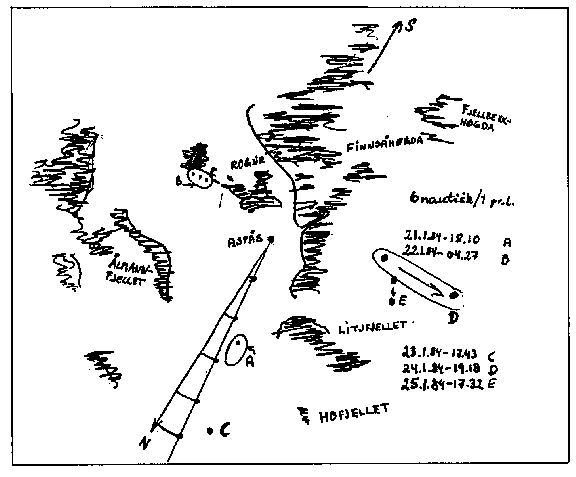
Radar recordings Friday 27 January. [s. 53]
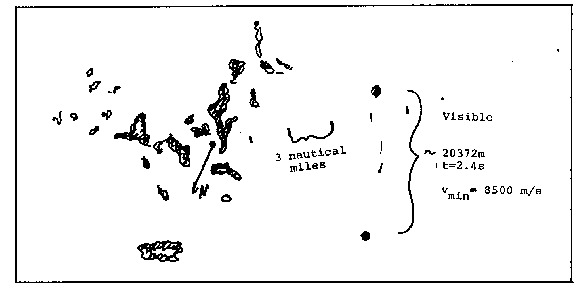
Radar recordings Saturday 4 February. [s. 54]
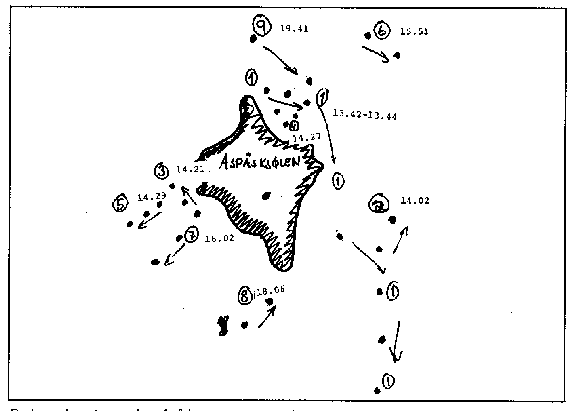
Radar recordings Saturday 28 January and Sunday 29 January.
[s. 54]
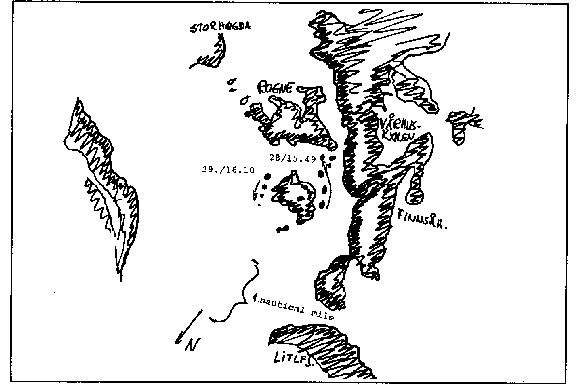
Radar recordings Sunday 5 February and Monday 6 February.
[s. 55]
Radar recordings Friday 3 February. [s. 55]
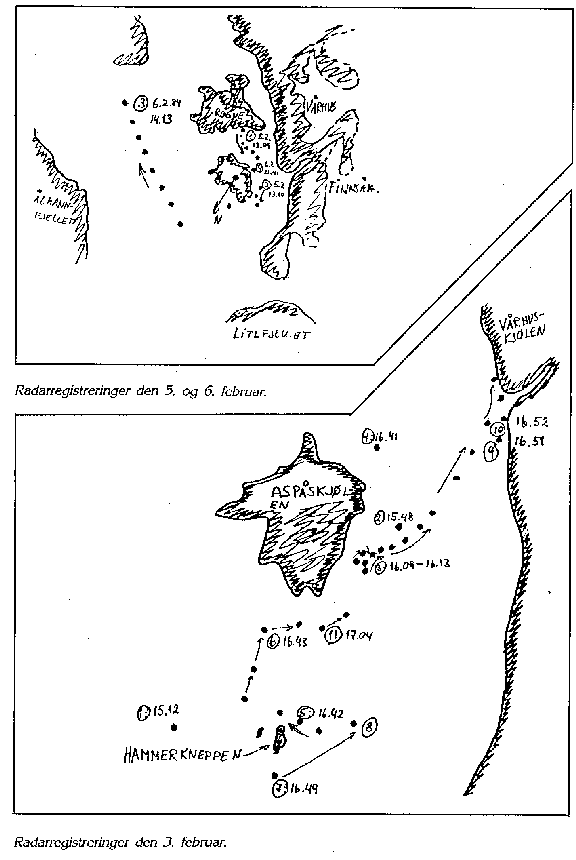
A film from the radarscreen showing radar recordings during the 2.fieldwork, in January 1985.
A5. Registrations on spectrum analyser
We had some registrations on the spectrum analyser. They can
be split into two main categories. One of these can easily be
explained as a radio transmitter in the valley. It was a
single-frequency component. I include these registrations in
the list, because we have not localized this transmitter. The
source is therefore unknown. The frequencies were always
different. This type of registration is called (1).
The second type of registration is called (2). This one was
more strange. It was "spikes" with almost equal amplitude,
with 80 MHz between each, all over the frequency-band, from
100 kHz to 1250 MHz. The amplitude of these moved up and down.
When they were down, they were about 5 dB over the noise, and
when they were at the top, they were about 25-30 dB over the
noise.
-
Sun. 29 January
- from 19.25 to 19.33: A type (2) registration.
It moved up and down all the time.
-
Sun. 29 January at 21.38: A type (2) registration. Only for a
short time.
Tue. 31 January - from 15.42 to 15.44: A type (2) registration.
Now periodic. It lasted a few seconds, then it stopped for a
short time, started again and lasted for a few seconds.. and
so on.
-
Tue. 31 January
- at 16.42: A type (2) registration. Again
periodic, but now the total time was almost one minute.
Fri. 3 February - at
16.44: A type (2) registration. Only a short time.
18.08: --- " ---
19.51: --- " ---
19.52: --- " ---
19.55: --- " ---
20.01: --- " ---
-
Thu. 9 February at 19.36: A type (1) registration at 145 MHz.
A "spike" moved up and down twice.
Thu. 9 February at 20.04: A type (1) registration at 130 MHz.
A "spike" showed up twice. 3 seconds between each.
Fri. 17 February at 17.49: A type (1) registration at 1070
MHz. A "spike" showed up two times. The amplitude was 22.5 dB
over the noise level.
Sun. 19 February at 20.59: A type (1) registration at 1115
MHz. The amplitude was 12.5 dB over the noise level.
A6. Registrations on magnetograph
The magnetograph we used, Fluxgate magnetometer model FM100,
has an upper frequency of 0.5 Hz. Any magnetical fluctuation
with a frequency higher than 0.5 Hz will be suppressed. The
instrument is built to register slow-varying magnetical
fluctuations. The pulsations might have a higher frequency
than 0.5 Hz, typically 2 Hz. They are usually recorded with a
special instrument, a pulsation magnetometer. We didn't have
this instrument, therefore we cannot be sure to have recorded
all pulsations. The pulsations included in this list are those
that could clearly be read out of the recordings.
We have not found any simple correlation with the slow-varying
magnetical fluctuations, that is why no copy of the recordings
(which is several meters long) is included in the report.
In the list, there is first the approximate time, then on
which coordinate it is recorded. At the end it indicates the
approximate amplitude of the pulsation. This have to be
approximate, because we don't know the exact frequency of the
pulsation. If the frequency is 2 Hz, and the suppression is 20
dB/decade in the instrument, this pulsation will be suppressed
about 14 dB.
The readings are divided in three types: Strong, medium and
weak.
- Strong is a reading of about 10 gamma.
- Medium is a reading of about 2 gamma.
- Weak is a reading of about 0.5 gamma.
The actual amplitude might be higher than this, because of the
suppressing in the instrument. The instrument could record the
magnetical field in all three coordinates. We had a printer
that had only two channels. We chosed channel X (towards
north) and Y (towards east).
From Saturday 11 February at 16.12 to Sunday 12 February at
12.20.
16.16-16.17
17.51-17.54 on X and Y - strong
18.00-18.03 X - weak
18.40-18.42 on X and Y - medium
18.45-18.46 X - weak
19.23-19.25 Y - strong
19.55-19.57 Y - strong
20.45-20.48 Y - weak
21.04-21.06 X (and Y?) - very strong
21.09- a few seconds, X and Y - both strong, X stronger
21.10-21.11 X and Y - both strong, X stronger
21.14 and 21.15 both times a few seconds, X and Y - both strong
21.18-21.20 X - weak
21.28-21.30 X - medium
21.56-22.00 X - weak
22.20 - a few seconds, X and Y - strong
22.32 - some seconds (30), X and Y - strong
22.48 - some seconds, X and Y - strong
00.08-00.10 Y - weak
00.27-00.30 X - weak
01.35-01.42 X - weak
After this quite a few ones were observed. Some of them were
hard to notice, while four were a little stronger than the
others.
From Sunday 12 February at 15.32 to Monday 13 February at
10.07.
17.51-17.53 X - medium
18.17-18.20 X - medium
18.50-18.51 X - weak
19.36-19.39 X - medium
19.55-20.07 Y - weak
20.41-20.44 X - weak
21.41-21.49 Y - weak
22.48-22.50 Y - weak
After that a magnetical storm came up, and it was therefore
difficult to read the pulsations. Besides, during a storm
there will usually be many pulsations. The storm vanished at 6
o'clock on Monday 13. After that we can see pulsations at:
08.53-09.00 X - weak
09.37-09.48 Y - weak
From Monday 13 February at 10.07 to Tuesday 14 February at
03.02.
11.02-11.05 X and Y - weak
11.27-11.31 Y - weak
12.14-12.17 Y - medium
12.36-12.38 Y - weak
15.45-15.47 X - weak
17.05-17.07 Y - weak
18.13-18.14 Y - weak
After that a magnetical storm came up. It ended at 19.50.
20.12-20.13 X - weak
20.21-20.24 Y - weak
No more pulsations until a second storm started at 01.00.
From Tuesday 14 February at 03.07 to Wednesday 15 February at
11.31.
The storm ended at 11.00 o'clock.
14.52-14.54 X - medium
15.38-15.39 X - weak
16.49-16.55 Y - medium
17.14-17.16 X - medium
18.36-18.39 Y - weak
19.15-19.17 X - medium
20.18-20.21 X - medium
20.24-20.34 Y - weak
22.24-22.29 Y - weak
A storm between 23.55 and 00.53.
01.32-01.33 Y - weak
03.03-03.06 Y - weak
04.11-04.13 Y - weak
06.21-06.30 Y - weak
10.32-10.48 X - medium
During the period from 15 February to 26 February, the
recordings were made by the Esterline-Angus graphic Ampmeter.
That means that no fluctuations could be measured. A few times
during that period, the needle made a fast movement. This
happened also a couple of times when a light was seen. Whether
this fast movement was caused by a pulsation or not, is
difficult to say.
From Saturday 25 February at 17.30 to Sunday 26 February at
11.31.
17.54-17.58 X - medium
19.10-19.30 X - medium
23.06-23.07 X and Y - weak
23.20-23.24 X - weak
01.28-01.32 X - medium
02.34-02.48 Y - medium
03.32-04.02 X - medium
04.20-05.02 X - medium
04.30-04.34 Y - medium
08.14-08.26 Y - medium
08.34-09.26 Y - medium
Temperature measurements
From the 21.January to the 31.January 1984
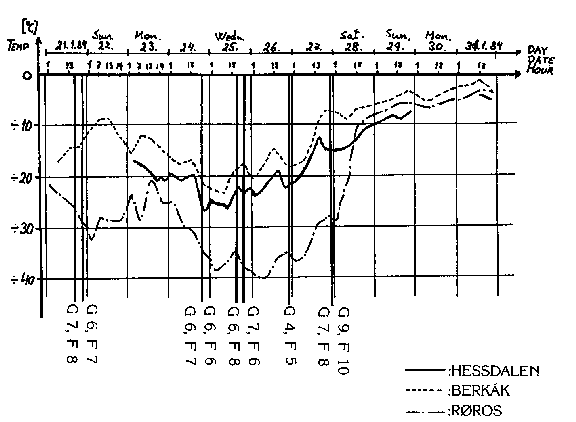
From the 1.February to the 11.February 1984
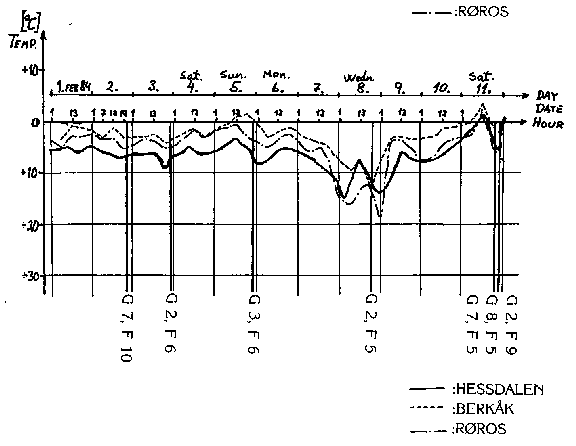
From the 12.February to the 23.February 1984

Aeromagnetic map of Hessdalen
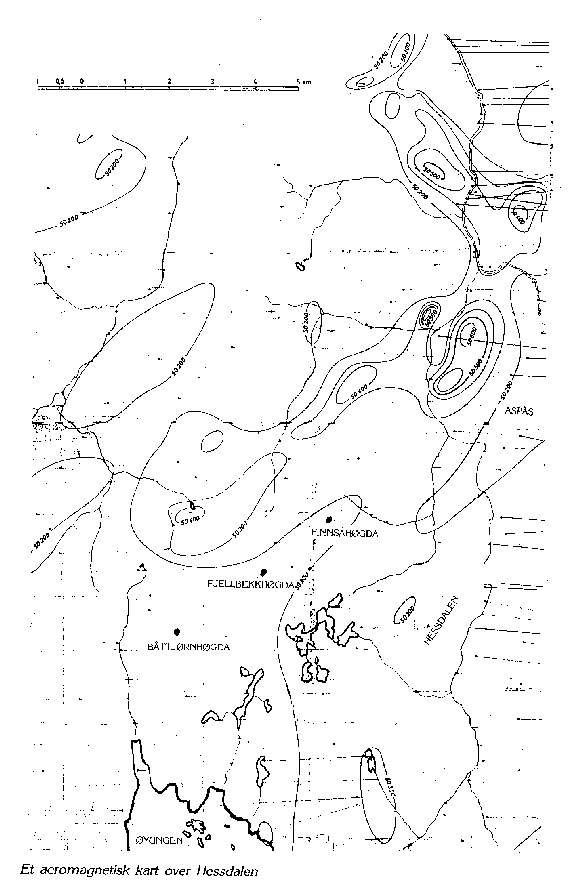
Geologic map of Hessdalen
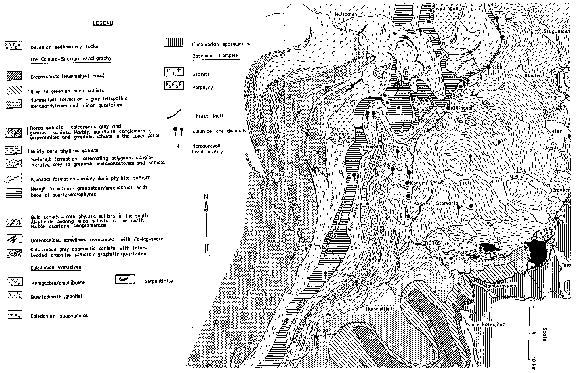
Pictures

|
Photo taken by Arne P. Thomassen 25. October 1982. It is taken with a 400 mm lens in
front, from the mountain Finnsåhøgda south, looking towards east.
Fig. A1
|

|
Photo taken by Arne P. Thomassen Oktober 1982. It is taken with a 400 mm lens in
front, from the mountain Finnsåhøgda south, looking towards east.
Fig. A2
|

|
Photo taken by Arne P. Thomassen Oktober 1982. It is taken with a 400 mm lens in
front, from the mountain Finnsåhøgda south, looking towards east.
Fig. A3
|

|
Fig. A4 These two pictures are taken by Leif Havik 12
February at 17.53. They are taken from Litlfjellet towards
Hessdalen. In the upper picture you can see the northern part
of Aspåskjølen. The light moved towards Litlfjellet, followed
the valley to the left. The lower picture is taken just before
the light disappears behind the mountain in the eastern part
of Litlfjellet. He used a Nikon FG with a 50 mm lens.
Fig. A5
|

|

|
Photo taken by Arne P. Thomassen on 25 September between 19.00 and 20.30. It is taken with a 400 mm lens in
front, from the mountain Finnsåhøgda south, looking towards east.
Fig. A6
|

|
Photo showing the third category: Three lights
together. The light at the right is red, and the two others
are yellow-white. Leif Havik shot the picture on 18 March
1982, at 19.33. He used a Practica LTL-3 camera with a 135 mm
lens equipped with a 2x teleconverter.
Fig. A7
|

|

|
Fig.A8
Two photos taken by Björn Lagesson on Sunday 26
February at 03.08. They are taken with a grating in front. The
lightstreak you see over the "lightpoint" is the spectrum of
the light. The shortest wavelength is nearest the light. The
picture at left is taken a few seconds before the picture at
right. The report was rated at F5. You may read more about this story in the report: "Spectrographic records".
|
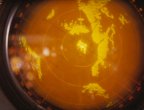
|
Fig. A9
Two photos showing a reflection on the
radarscreen. The reflection is marked. It is 1 nautical mile
between the circles.
Fig. A10
|
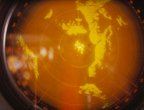
|

|
Picture taken from the headquarter towards
Vårhuskjølen at 28 January at 15.49. The picture is taken when
a strong reflection is seen on the radarscreen. As you see,
nothing special is seen in the picture.
Fig. A11
|

|
Photo taken by Roar Wister (RW1/3) Saturday 21
February at 19.23. Exposure time is 10 seconds. The aperture
is f/5.6. It is taken with a Pentax ME Super with a Vivitar
zoom lens with a range 75-205 mm, adjusted to 75 mm. Just
after the picture was taken, an oscillation could be seen by
the eyes. Probably the same oscillation which you see the
start of in the picture. The frequency is 7 Hz.
Fig. A12
|
Fig. A14 - The headquarter at Aspåskjølen, seen from
southeast.

|
Fig. A20
Photo showing two moving lights over Finnsåhøgda
(X/4). The picture above is enlarged. The picture below is
grossly enlarged.
Fig. A20x
|
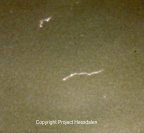
|
Fig. A21 - Photo taken by Erling Strand (ES1/13) on Saturday
21 January between 19.20 and 19.30.
Fig. A22 - Photos taken by Arne P. Thomassen on Wednesday 25
January at 19.10 (APT1/22,23). It is possible to see some kind
of spectrum from 560 to 630 nm.
|


